[DAIWA] 24 LUVIAS (LT, SF, ST LT, ST SF) [LUVIAS] Series Specification List
Please contact us from here for the price.
Item Description
| 24 LUVIAS LT
| Model | Weight (g) |
Retrieve Length (cm/ Per Handle Rotation) |
Gear Ratio | Line Capacity Nylon (lb-m) |
Line Capacity PE (No.-m) |
| LT2000S-P | 145 | 64 | 4.9 | 3-150 | 0.4-200 |
| LT2000S-H | 145 | 76 | 5.8 | 3-150 | 0.4-200 |
| LT2500S | 150 | 72 | 5.1 | 4-150 | 0.6-200 |
| LT2500S-DH | 165 | 72 | 5.1 | 4-150 | 0.6-200 |
| LT2500S-XH | 150 | 87 | 6.2 | 4-150 | 0.6-200 |
| PC LT2500 | 170 | 73 | 5.2 | 6-150 | 0.8-200 |
| PC LT2500-H | 170 | 80 | 5.7 | 6-150 | 0.8-200 |
| LT3000-H | 175 | 85 | 5.7 | 8-150 | 1-200 |
| PC LT3000 | 205 | 77 | 5.2 | 8-150 | 1-200 |
| PC LT3000-XH | 205 | 93 | 6.2 | 8-150 | 1-200 |
| LT4000-XH | 215 | 99 | 6.2 | 12-150 | 1.5-200 |
| LT5000D-CXH | 225 | 105 | 6.2 | 25-150 | 2.5-300 |
| Model | Handle Arm Length (mm) |
Bearings BB/Roller |
Max Drag (kg) |
Handle Knob Spec |
JAN |
| LT2000S-P | 40 | 9/1 | 5 | HG-I | 4550133388958 |
| LT2000S-H | 45 | 9/1 | 5 | HG-I | 4550133388965 |
| LT2500S | 50 | 9/1 | 5 | HG-I | 4550133388972 |
| LT2500S-DH | 90 | 10/1 | 5 | HG-I | 4550133388989 |
| LT2500S-XH | 50 | 9/1 | 5 | HG-I | 4550133388996 |
| PC LT2500 | 50 | 9/1 | 10 | HG-T | 4550133389009 |
| PC LT2500-H | 55 | 9/1 | 10 | HG-T | 4550133389016 |
| LT3000-H | 55 | 9/1 | 10 | HG-T | 4550133389023 |
| PC LT3000 | 60 | 9/1 | 10 | HG-T | 4550133389030 |
| PC LT3000-XH | 60 | 9/1 | 10 | HG-T | 4550133389047 |
| LT4000-XH | 60 | 9/1 | 12 | HG-T Large | 4550133389054 |
| LT5000D-CXH | 60 | 9/1 | 12 | EVA Round Light Knob |
4550133389061 |
| 24 LUVIAS ST LT
| Model | Weight (g) |
Retrieve Length (cm/ Per Handle Rotation) |
Gear Ratio | Line Capacity Nylon (lb-m) |
Line Capacity PE (No.-m) |
| ST LT2000S-P | 145 | 64 | 4.9 | 3-150 | 0.4-200 |
| ST LT2500S-XH | 150 | 87 | 6.2 | 4-150 | 0.6-200 |
| Model | Handle Arm Length (mm) |
Bearings BB/Roller |
Max Drag (kg) |
Handle Knob Spec |
JAN |
| ST LT2000S-P | 40 | 9/1 | 5 | HG-I Type | 4550133389184 |
| ST LT2500S-XH | 50 | 9/1 | 5 | HG-I Type | 4550133389191 |
| 24 LUVIAS SF
| Model | Weight (g) |
Retrieve Length (cm/ Per Handle Rotation) |
Gear Ratio | Line Capacity Nylon (lb-m) |
Line Capacity PE (No.-m) |
| SF2000SS-P | 135 | 60 | 4.6 | 2.5-100 | 0.3-200 |
| SF2000SS-H | 135 | 74 | 5.7 | 2.5-100 | 0.3-200 |
| SF2500SS | 140 | 70 | 5 | 3-150 | 0.4-200 |
| SF2500SS-H | 140 | 80 | 5.7 | 3-150 | 0.4-200 |
| Model | Handle Arm Length (mm) |
Bearings BB/Roller |
Max Drag (kg) |
Handle Knob Spec |
JAN |
| SF2000SS-P | 40 | 8/1 | 3 | HG-I Type Finesse | 4550133389207 |
| SF2000SS-H | 45 | 8/1 | 3 | HG-I Type Finesse | 4550133389214 |
| SF2500SS | 45 | 8/1 | 3 | HG-I Type | 4550133389221 |
| SF2500SS-H | 45 | 8/1 | 3 | HG-I Type | 4550133389238 |
| 24 LUVIAS ST SF
| Model | Weight (g) |
Retrieve Length (cm/ Per Handle Rotation) |
Gear Ratio | Line Capacity Nylon (lb-m) |
Line Capacity PE (No.-m) |
| ST SF1000S-P | 135 | 57 | 4.6 | 2.5-100 | 0.3-200 |
| ST SF2000SS-P | 135 | 60 | 4.6 | 2.5-100 | 0.3-200 |
| ST SF2000SS-H | 135 | 74 | 5.7 | 2.5-100 | 0.3-200 |
| ST SF2500SS-H | 140 | 80 | 5.7 | 3-150 | 0.4-200 |
| Model | Handle Arm Length (mm) |
Bearings BB/Roller |
Max Drag (kg) |
Handle Knob Spec |
JAN |
| ST SF1000S-P | 35 | 8/1 | 3 | HG-I Type Finesse | 4550133389146 |
| ST SF2000SS-P | 40 | 8/1 | 3 | HG-I Type Finesse | 4550133389153 |
| ST SF2000SS-H | 45 | 8/1 | 3 | HG-I Type Finesse | 4550133389160 |
| ST SF2500SS-H | 45 | 8/1 | 3 | HG-I Type | 4550133389177 |
* Line capacity values are a guide and vary depending on manufacturer, item, and winding tension.
* Retrieve length is the length per one handle rotation.
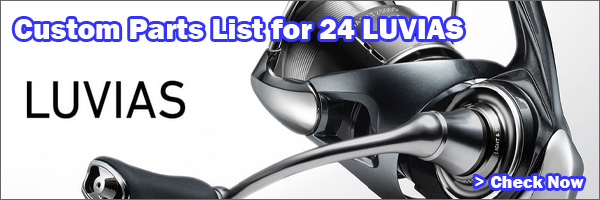
Inheritance and Evolution of Lightness. LUVIAS
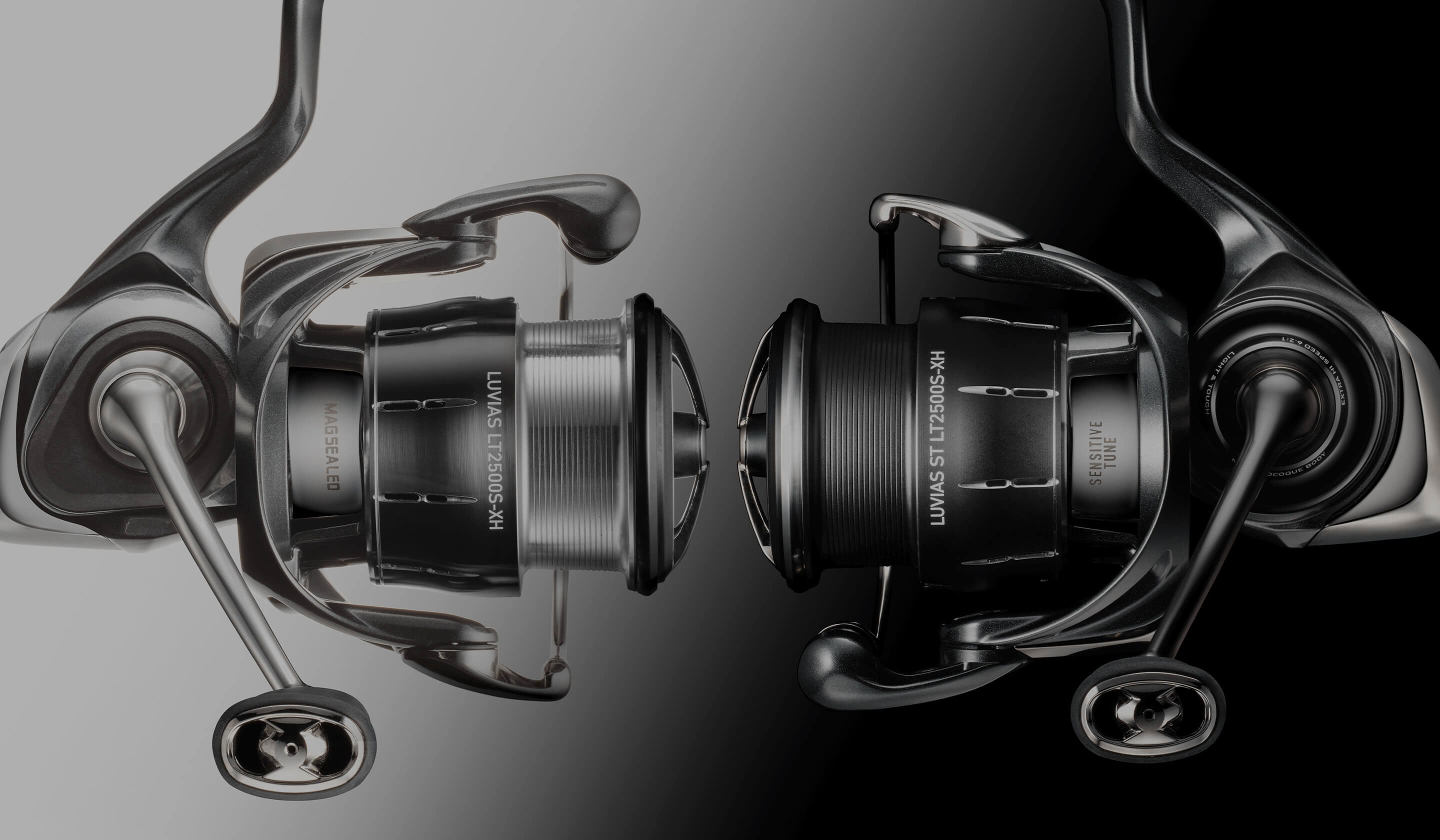
LUVIAS, which achieves both significant weight reduction and nimble operability, spreads its wings into four series that commit to the times.
If you seek it, anyone can step into that world.
Together with LUVIAS, the symbol of lightness.
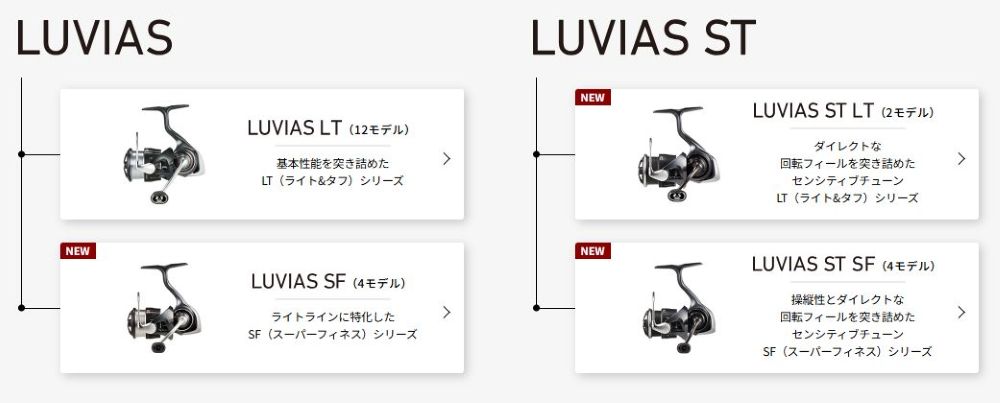
LUVIAS
- LUVIAS LT (12 Models)
A Series That Pursues Fundamental Performance
LT (Light& Tough) Series
- LUVIAS SF (4 Models)
A Series Specialized for Light Lines
SF (Super Finesse) Series
LUVIAS ST
- LUVIAS ST LT (2 Models)
Sensitive Tune Pursuing
a Direct Rotational Feel
LT (Light & Tough) Series
- LUVIAS ST SF (4 Models)
Sensitive Tune Pursuing
Operability and Direct Rotational Feel
SF (Super Finesse) Series
DAIWA Technology
AIRDRIVE DESIGN
A next-generation spinning reel design philosophy that pursues lure control exactly as the angler intends.
AIRDRIVE DESIGN consists of up to four technologies.
As a prerequisite, it equips the AIRDRIVE ROTOR that produces light start-up and high-response rotation, paired with the lightweight, trouble-free AIRDRIVE BAIL; the thin-walled AIRDRIVE SPOOL engineered by shaving unnecessary material to the limit; and the AIRDRIVE SHAFT that supports the main shaft with high-precision collars and separates it from the pinion gear to enable light winding with extremely little rotational noise even under high load.
Through their synergy and improved reel weight balance, operability is achieved at a higher dimension.
* LT models are equipped with AIRDRIVE ROTOR, AIRDRIVE BAIL, AIRDRIVE SPOOL, and AIRDRIVE SHAFT.
* SF models are equipped with AIRDRIVE ROTOR, AIRDRIVE BAIL, and AIRDRIVE SPOOL, with Linear Shaft spec.
AIRDRIVE ROTOR
Based on a unique theory, a new shape that seems cut directly from a sphere was derived, then further weight was removed thoroughly while maintaining rigidity to realize a major weight reduction.
Start-up lightness, which leads to improved operability and sensitivity, is dramatically enhanced.
AIRDRIVE BAIL
Evolving the air bail that adopted a hollow pipe structure for rigidity and lightness, the bail diameter is further reduced while maintaining required strength to achieve greater weight savings.
The bail angle is set with an optimal tilt so that the line can transition more smoothly from the bail to the line roller.
Even lighter weight and improved trouble-free performance are realized.
AIRDRIVE SPOOL
A thin-wall design that strips unnecessary material to the limit, pursuing weight reduction.
From the thin skirt to internal cutouts, the spool is thoroughly lightened.
A lighter spool improves start-up and operability during casting and other actions.
In addition, a low-resistance drag click mechanism enhances drag response during operation.
AIRDRIVE SHAFT
A system that sets the main shaft and pinion in a non-contact structure to make friction resistance zero (Linear Shaft), then supports both ends of the pinion with BBs to translate input power maximally into rotational force.
Supporting the main shaft with high-precision collars further reduces rotational noise to the utmost.
* SF features the Linear Shaft spec.
MONOCOQUE BODY
A toughness and durability technology: the Monocoque Body.
Conventional spinning reels typically support both ends of the drive gear with a body and body cover, fixed by several screws.
Aiming for further precision and rigidity, the body cover was eliminated, fixing a high-precision plate screwed directly into the body—this is the Monocoque Body.
This increases gear support precision as well as rigidity and sealing performance.
Furthermore, by using space previously taken by screws, the drive gear size was expanded to the extreme.
Monocoque Body means MONO (one) - COQUE (shell).
Like the toughness of a single shell, this entirely new shape breaks the conventions of reel construction.
MAGSEALED
DAIWA’s unique waterproof structure that creates a wall of magnetic oil in the gap between body and rotor to shut out seawater and dust.
* On 24 LUVIAS and 24 LUVIAS SF, MAGSEALED is applied to the pinion area.
ZAION
DAIWA’s proprietary molding of a special resin densely woven with carbon fibers—extremely difficult to process.
The pinnacle of DAIWA carbon material that combines astonishing lightness and strength.
Only upper-tier models are permitted to wear this performance.
* 24 LUVIAS uses ZAION for both body and rotor.
TOUGH DIGIGEAR
Withstanding harsh environments requires a tough heart that supports the reel.
“TOUGH DIGIGEAR” delivers longer-lasting smooth rotation.
ATD TYPE-L
ATD works smoothly in tune with fish pull and continues to operate seamlessly.
ATD TYPE-L further enhances initial response.
Pursuing smooth start-up and followability allows you to focus on the fight without worrying about drag settings.
* Equipped on LT2000S-P to LT4000-XH and SF models.
ATD TOUGH
ATD works smoothly with fish pull and keeps operating seamlessly.
ATD TOUGH employs carbon washers for high durability.
Pursuing smooth start-up and followability allows you to focus on the fight without worrying about drag settings.
* Equipped on 5000 size.
LC-ABS (Long Cast ABS)
Maintaining the ABS II concept of reducing contact resistance, the contact point is moved forward for even smoother line release.
With the ring positioned forward, line is less likely to ride on the ring, achieving about 5% more distance and improved trouble-free performance over ABS II.
A next-generation ABS spool that realizes LC (= Long Cast).
Product Details
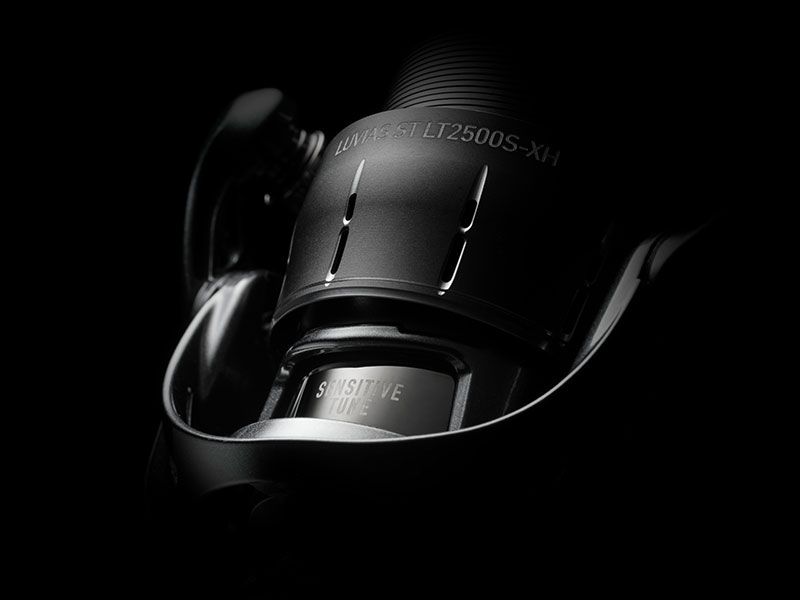
| SENSITIVE TUNE
A special tune that changes the rotation-critical BBs (bearings) directly linked to start-up lightness from grease-spec BBs (CRBB) on the standard model to oil-spec BBs, achieving a delicate and direct winding feel.
Furthermore, because it is premised on use for finesse fishing, the MAGSEALED on the pinion area is removed to reduce weight as much as possible.
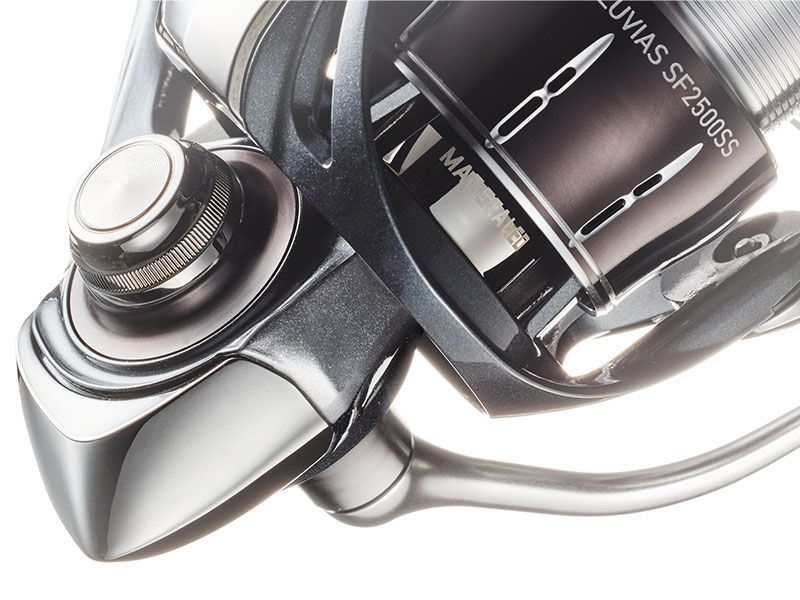
| Stopper-Less Body
By eliminating the anti-reverse lever (stopper), the body structure is made simpler.
Removing the stopper—an ingress route for water and debris—not only reduces weight and improves waterproof performance, but also minimizes the chance of sudden troubles in harsh environments or during battles with large fish expected of 24 LUVIAS.
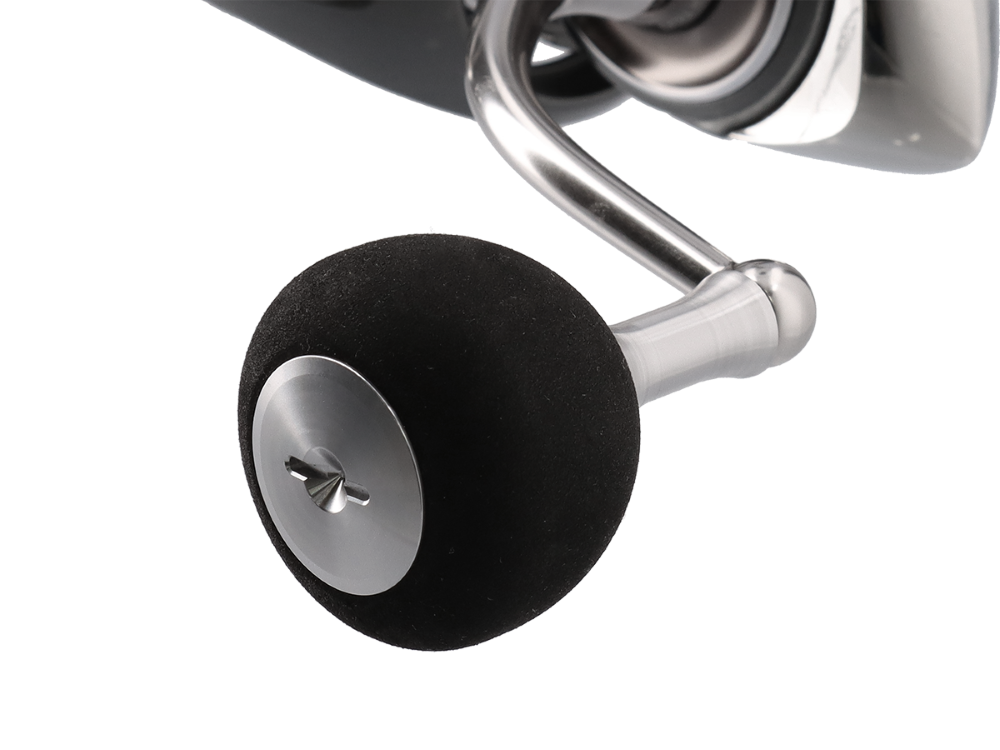
| EVA Round Light Knob (Equipped on 5000 Size)
LT5000D-CXH, intended for surf fishing and light shore jigging, comes standard with a power-light-type EVA knob for high-load fishing.
The round knob shape with high winding torque supports retrieval under heavy load.
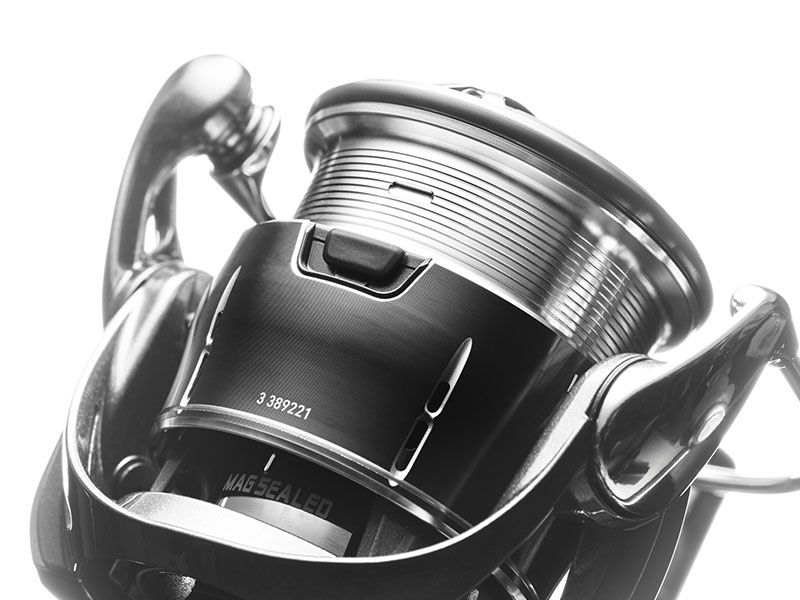
| Perfect Line Stopper
A new line stopper shape compatible with both thin lines like PE and thicker leaders.
The horizontally elongated shape saves vertical space and contributes to spool weight reduction.
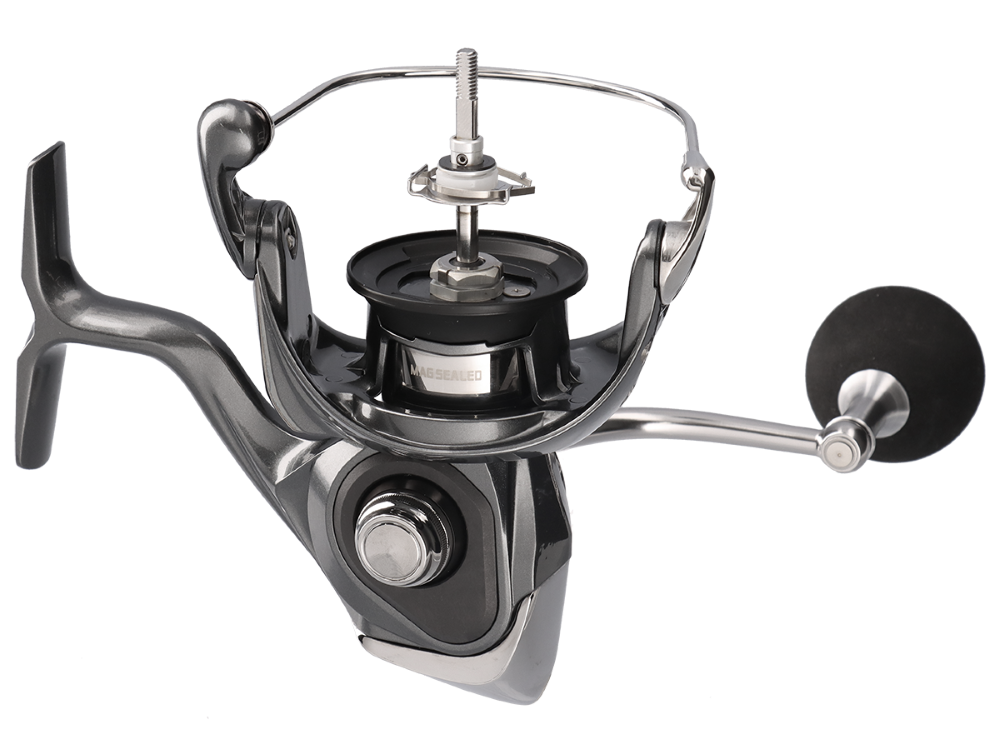
| Main Shaft
Materials are optimized by item according to usage.
Lightweight aluminum main shafts are used on items where low weight is required from LT2000S-P to LT3000-H.
Meanwhile, SUS (stainless steel) main shafts are adopted for the four items where higher rigidity is required: PC LT3000, PC LT3000-XH, LT4000-XH, and LT5000D-CXH.
LT4000-XH and LT5000D-CXH achieve 12 kg drag values.
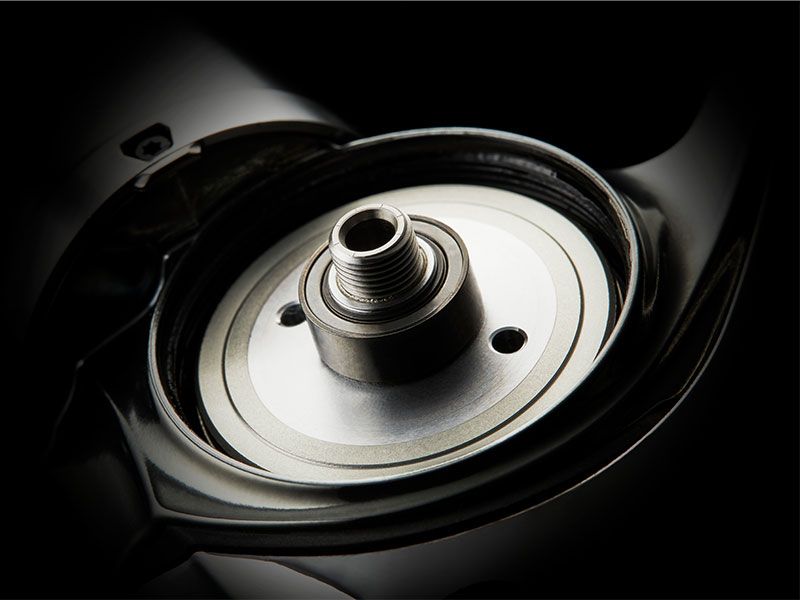
| Super Duralumin MC (Machine-Cut) TOUGH DIGIGEAR
The super duralumin MC TOUGH DIGIGEAR mounted on 24 LUVIAS uses a high-strength cold-forged material finished with high-precision machine cutting to realize the ideal gear.
In particular, for the five mid/large body items with greater load on the drive gear (PC LT2500-H, LT3000-H, PC LT3000-XH, LT4000-XH, LT5000D-CXH) and the SF models, a special surface treatment increases gear surface hardness to reduce adverse effects from unexpected shocks.
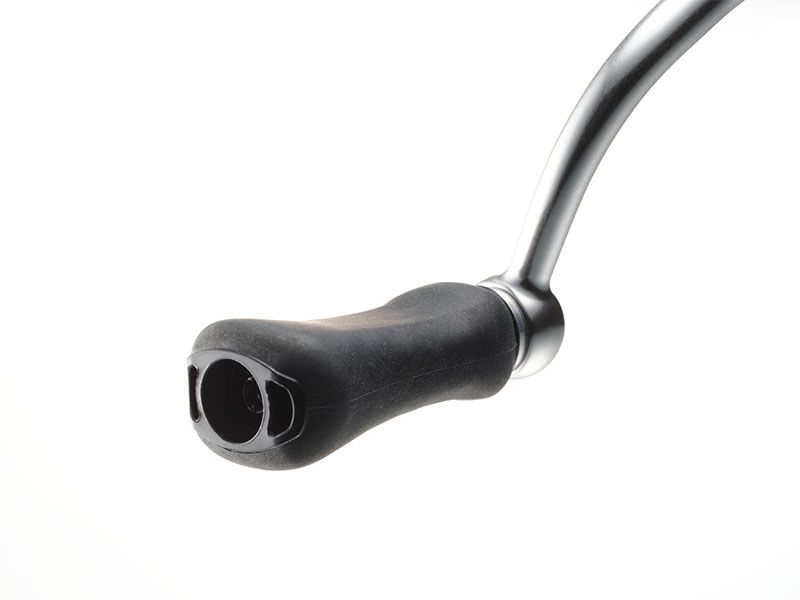
| High-Grip I-Type Finesse Knob
Adopts the “High-Grip I-Type Finesse Knob,” ideal for delicate fishing.
The weight-reduced, drilled knob enables light reeling, contributing to improved sensitivity.
Despite its compact, lightweight size, the high-grip spec ensures solid grip performance and easy handling.
Pursuing weight reduction, a one-piece knob cap structure is adopted.
* Use a 2.5 mm hex wrench to remove the handle knob.
* Standard on SF1000S-P, SF2000SS-P, and SF2000SS-H.
| Ball Bearing Locations (Five Items from LT2000S-P to LT2500S-XH)
9 BBs (double handle model has 10 BBs)
- Pinion: 2 BB (SUS)
- Drive Gear: 2 BB (SUS)
- Line Roller: 2 BB (CRBB)
- Handle Knob: 1 BB (SUS)
(Double handle model: 2 BB)
- Main Shaft: 1 BB (CRBB)
- Oscillation Gear: 1 BB (CRBB)
| Ball Bearing Locations (Three Items from PC LT2500 to LT3000-H)
9 BBs
- Pinion: 2 BB (SUS, CRBB)
- Drive Gear: 2 BB (SUS)
- Line Roller: 2 BB (CRBB)
- Handle Knob: 1 BB (SUS)
- Main Shaft: 1 BB (CRBB)
- Oscillation Gear: 1 BB (CRBB)
| Ball Bearing Locations (Four Items from PC LT3000 to LT5000D-CXH)
9 BBs
- Pinion: 2 BB (CRBB)
- Drive Gear: 2 BB (SUS)
- Line Roller: 2 BB (CRBB)
- Handle Knob: 1 BB (SUS)
- Main Shaft: 1 BB (CRBB)
- Oscillation Gear: 1 BB (CRBB)
| Ball Bearing Locations (Four SF Items)
8 BBs
- Pinion: 1 BB (SUS)
- Drive Gear: 2 BB (SUS)
- Line Roller: 2 BB (CRBB)
- Handle Knob: 1 BB (SUS)
- Main Shaft: 1 BB (CRBB)
- Oscillation Gear: 1 BB (CRBB)
| LUVIAS ST LT Ball Bearing Locations
9 BBs
- Pinion: 2 BB (SUS)
- Drive Gear: 2 BB (SUS)
- Line Roller: 1 BB (CRBB)
- Handle Knob: 1 BB (SUS)
- Main Shaft: 1 BB (SUS)
- Oscillation Gear: 1 BB (SUS)
* Oil-spec BBs are used at the pinion, drive gear, main shaft, and oscillation gear.
| LUVIAS ST SF Ball Bearing Locations
8 BBs
- Pinion: 1 BB (SUS)
- Drive Gear: 2 BB (SUS)
- Line Roller: 2 BB (CRBB)
- Handle Knob: 1 BB (SUS)
- Main Shaft: 1 BB (SUS)
- Oscillation Gear: 1 BB (SUS)
* Oil-spec BBs are used at the pinion, drive gear, main shaft, and oscillation gear.
LUVIAS LT
In the 20th year since LUVIAS was born, the 6th-generation LUVIAS debuts.
With a ZAION body × ZAION rotor, it achieves at a high level the two opposing performances of lightness and rigidity.
AIRDRIVE DESIGN further polishes operability, enabling lure control exactly as intended.
To deliver LUVIAS to more anglers, a 5000-size item has been added, offering a lineup suitable for a wide range of fishing styles.
Design is optimized to usage—drag, main shaft materials, drive gear surface treatment, and more are selected for the intended purpose.
Item Guide & Target Fish Reference
| Model | Description |
| LT2000S-P | A model for light games such as area trout, horse mackerel (Aji) and rockfish (Mebaru). Makes stable reeling use of 64 cm per handle turn. The 145 g lightness is a major advantage for delicate fishing with lightweight lures. [Target Fish Reference] Area trout, Aji (Horse mackerel), Mebaru (Rockfish), etc. |
| LT2000S-H | Leverages faster retrieve for native trout in headwaters, or taking up line slack in area trout fishing (bottom lift & fall, minnow jerking, etc.). Also recommended for light salt games such as Aji (Horse mackerel)/Mebaru (Rockfish). The 145 g lightness is a major advantage for delicate fishing with lightweight lures. [Target Fish Reference] Native trout in headwaters and streams, area trout, Aji (Horse mackerel), Mebaru (Rockfish), etc. |
| LT2500S | An astonishing 150 g in the 2500 class—recommended for bass light rigs and Egi (squid) fishing. Also a versatile choice in light salt games. [Target Fish Reference] Bass fishing, Eging (Squid Jig Fishing), Aji (Horse mackerel), Mebaru (Rockfish), etc. |
| LT2500S-DH | Double handle tuned for Eging (Squid Jig Fishing). A featherweight 165 g—delivers maximum performance for a full day of jerking. [Target Fish Reference] Eging (Squid Jig Fishing) |
| LT2500S-XH | Versatile model focused on retrieve speed. With 87 cm per handle turn, ideal for fast-paced methods such as bass light rigs. [Target Fish Reference] Eging (Squid Jig Fishing), Bass, Trout, etc. |
| PC LT2500 |
PC = Power Custom in 2500 size. Combines a one-size-larger body than LT2500-class items (LT2500S, LT2500S-DH, LT2500S-XH) with a 2500-size rotor & spool to realize high winding power. Optimal for light power finesse with PE line and boat Eging (Squid Jig Fishing). [Target Fish Reference] Bass PE, Eging (Squid Jig Fishing), Boat Eging (Squid Jig Fishing), Sea Bream (Tenya) etc. |
| PC LT2500-H |
PC = Power Custom in 2500 size. Compared to LT2500-class items (LT2500S, LT2500S-DH, LT2500S-XH), combines a one-size-larger body with a 2500 rotor & spool for high winding power. High-gear model with 80 cm per turn—ideal for quick cycling. Also optimal for light power finesse with PE line and boat Eging (Squid Jig Fishing). [Target Fish Reference] Bass PE, Eging (Squid Jig Fishing), Boat Eging (Squid Jig Fishing), Sea Bream (Tenya) etc. |
| LT3000-H | A utility model accommodating various targets such as bay-area seabass and mid-size river char/trout (Iwana, Yamame, Amago). [Target Fish Reference] Eging (Squid Jig Fishing), Seabass, Bass, Native Trout, Sea Bream (Tenya) etc. |
| PC LT3000 |
PC = Power Custom in 3000 size. Compared to LT3000-H, combines a larger body with a 3000-size rotor & spool to realize higher lifting power. Recommended for SLJ (super light jigging) and casting Tai Rubber leveraging winding power. [Target Fish Reference] Seabass, SLJ, Tai Rubber, Large Trout, etc. |
| PC LT3000-XH |
PC = Power Custom in 3000 size. Compared to LT3000-H, combines a larger body with a 3000-size rotor & spool to realize higher winding torque. Extra-high-gear with 93 cm per turn—ideal for quick cycling. With high winding torque, recommended for high-load fishing such as seabass vibration games. Also recommended for SLJ and casting Tai Rubber leveraging winding power. [Target Fish Reference] Seabass, Tai Rubber, SLJ, Large Trout, etc. |
| LT4000-XH | The one reel for seabass games. Also optimal for light shore jigging targeting small pelagics, dorado, and bonito from rocks or surf, as well as mainstream cherry salmon and large lake trout. Extra-high-gear with 99 cm per turn—ideal for quick cycling. [Target Fish Reference] Seabass, Surf, Light Shore Jigging, Rock Seabass (Hirasuzuki), etc. |
| LT5000D-CXH | The largest size newly added to 24 LUVIAS—ideal not only for surf fishing targeting flatfish and seabass, but also for light shore jigging targeting small pelagics, dorado, and bonito. Deep spool holds PE No. 2.5 × 300 m and uses durable ATD TOUGH drag. The standard EVA Round Light Handle supports winding under heavy load. [Target Fish Reference] Seabass, Surf, Light Shore Jigging, Rock Seabass (Hirasuzuki), etc. |
Included Accessories
| LT Items
- Warning Card
- Spool Position Adjustment Washers
- Warning List (11 Languages)
- Simple Instruction Manual (4 Languages)
- Reel Bag
- Web Questionnaire Card
LUVIAS SF
An Invitation to the Super Finesse Realm.
Beyond reducing reel weight, improved weight balance reduces front-heaviness, achieving “evolved lightness” in 24 LUVIAS.
To that 24 LUVIAS, the 24 LUVIAS SF series is added, adopting the “SF Concept,” a spinning reel design philosophy that enables control in a super-finesse realm far beyond previous finesse.
While inheriting DAIWA technologies that support LUVIAS LT’s core performance—starting with AIRDRIVE DESIGN, plus a ZAION Monocoque Body and MAGSEALED—the SF dares to sacrifice some durability and versatility, strictly limiting targets and usable lines to pursue uncompromising compactness and lightness.
Weights are 135 g for SF2000 size and 140 g for SF2500 size.
We want more anglers than ever to feel the super-finesse world pioneered by EXIST SF and AIRITY SF.
Differences Between LUVIAS SF and LUVIAS LT
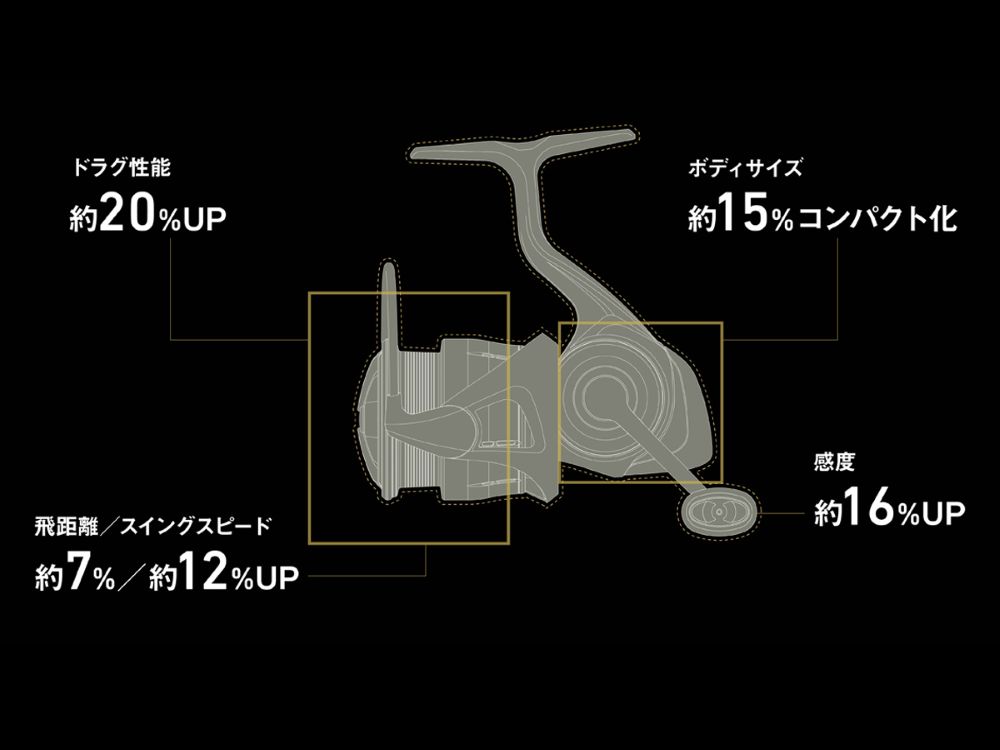
| 20% Drag Performance Up
A shorter spool suppresses variation in resistance during line release.
Changing the max drag to 3 kg widens the adjustment range in the low-drag region, crucial for finesse fishing, allowing finer, more optimal drag tuning.
| Casting Distance/Swing Speed Approx. +7%/+12%
Using an ultra-light tackle combo of SF2500SS and STEEZ RC61L-SV, swing speed is about +12% over existing tackle.
This improves long-cast performance with lightweight lures. For the same distance, you can cast with less force, also improving casting accuracy.
| Significant Weight Reduction
By making the body about 15% more compact, major weight reduction is achieved (LT2500S = 150 g vs. SF2500SS = 140 g).
| Approx. +16% Sensitivity Up
SF-specific internal parts, such as a smaller-diameter main shaft, improve vibration transmission.
* SF Series Usage Notes
1. Do not wind line under high tension.
We recommend winding at the suggested tension (Nylon/Fluoro/Ester: 100 g, PE: 200 g).
Excessive winding tension may deform the spool or cause rotation issues.
2. We recommend drag settings of 800 g or less.
Winding under high load can cause rotation issues.
Take care in reel retrieval when freeing snags or recovering lures with heavy weeds.
Do not overtighten the drag knob to avoid damage.
3. Developed assuming up to about 4 lb Nylon/Fluoro/Ester or up to about PE No. 0.6, but the strength standard is specialized for SF (Super Finesse). Use with care.
Item Guide
Item Guide & Target Fish Reference
| Model | Description |
| SF2000SS-P | Enables stable reeling utilizing 60 cm per handle turn. Recommended for constant-speed slow retrieves with spoons in area trout, and delicate fishing with lightweight jig heads for Aji (Horse mackerel). [Target Fish Reference] Area trout, Aji (Horse mackerel), Mebaru (Rockfish), etc. |
| SF2000SS-H | Leverages faster retrieve for native trout in headwaters and taking up line slack in area trout (bottom lift & fall, minnow twitching, etc.). Also recommended for light salt games such as Aji (Horse mackerel)/Mebaru (Rockfish). [Target Fish Reference] Native trout in headwaters/streams, area trout, Aji (Horse mackerel), Mebaru (Rockfish), etc. |
| SF2500SS | Recommended for bass fishing with light rigs. With 70 cm per handle turn, ideal for retrieve fishing such as with shads. [Target Fish Reference] Bass fishing |
| SF2500SS-H | Makes use of 80 cm per turn to excel at quick-cycling methods such as bass light rigs. [Target Fish Reference] Bass fishing |
Included Accessories
| SF Items
- Warning Card
- Spool Position Adjustment Washers
- Reel Bag
- Web Questionnaire Card
LUVIAS ST LT ・ LUVIAS ST SF
Reel Sensitivity That Connects You to the Water.
Based on the lightweight spinning reel “LUVIAS,” the special-tuned “24 LUVIAS ST (Sensitive Tune)” pursues even lighter winding and reduced weight.
The lineup consists of six models specialized for finesse fishing across ST LT and ST SF.
While maintaining the core performance of 24 LUVIAS LT/SF, the rotation-critical BBs directly linked to handle lightness are changed from grease-spec to oil-spec.
Abandoning the high durability characteristic of grease BBs and selecting low-viscosity oil BBs, the lightness of rotation is pushed to a higher level.
Additionally, the MAGSEALED on the pinion—key to waterproofing and dustproofing—is intentionally omitted, even obsessing over minor weight savings not shown in specs.
In design, based on 24 LUVIAS LT/SF, the spool is matte black, and the handle and engine plate are gunmetal (LUVIAS LT/SF are gunmetal × silver) to create a stoic worldview.
[Differences from 24 LUVIAS Standard Models]
1. Oil-spec BBs for rotation-critical bearings
2. No MAGSEALED
Item Guide & Target Fish Reference
| Model | Description |
| ST LT2000S-P |
LT (Light & Tough) model for versatile use. Enables stable reeling utilizing 64 cm per handle turn. [Target Fish Reference] Area trout, Aji (Horse mackerel), Mebaru (Rockfish), etc. |
| ST LT2500S-XH |
LT (Light & Tough) model for versatile use. With 87 cm per turn, ideal for quick-cycling methods such as bass light rigs. [Target Fish Reference] Eging (Squid Jig Fishing), Bass, Trout, etc. |
| ST SF1000S-P |
Enables stable reeling utilizing 57 cm per handle turn. Recommended for constant-speed slow spoon retrieves in area trout and delicate Aji (Horse mackerel) jigging with light heads. [Target Fish Reference] Area trout, Aji (Horse mackerel), Mebaru (Rockfish), etc. |
| ST SF2000SS-P |
Enables stable reeling utilizing 60 cm per handle turn. Recommended for constant-speed slow spoon retrieves in area trout and delicate Aji (Horse mackerel) jigging with light heads. [Target Fish Reference] Area trout, Aji (Horse mackerel), Mebaru (Rockfish), etc. |
| ST SF2000SS-H |
Leverages faster retrieve for native trout in headwaters and taking up line slack in area trout (bottom lift & fall, minnow twitching, etc.). Also recommended for light salt games such as Aji (Horse mackerel)/Mebaru (Rockfish). [Target Fish Reference] Native trout in headwaters/streams, area trout, Aji (Horse mackerel), Mebaru (Rockfish), etc. |
| ST SF2500SS-H |
Makes use of 80 cm per turn to excel at quick-cycling bass light rigs. [Target Fish Reference] Bass fishing |
Included Accessories
- Warning Card
- Spool Position Adjustment Washers
- Reel Bag
- Web Questionnaire Card
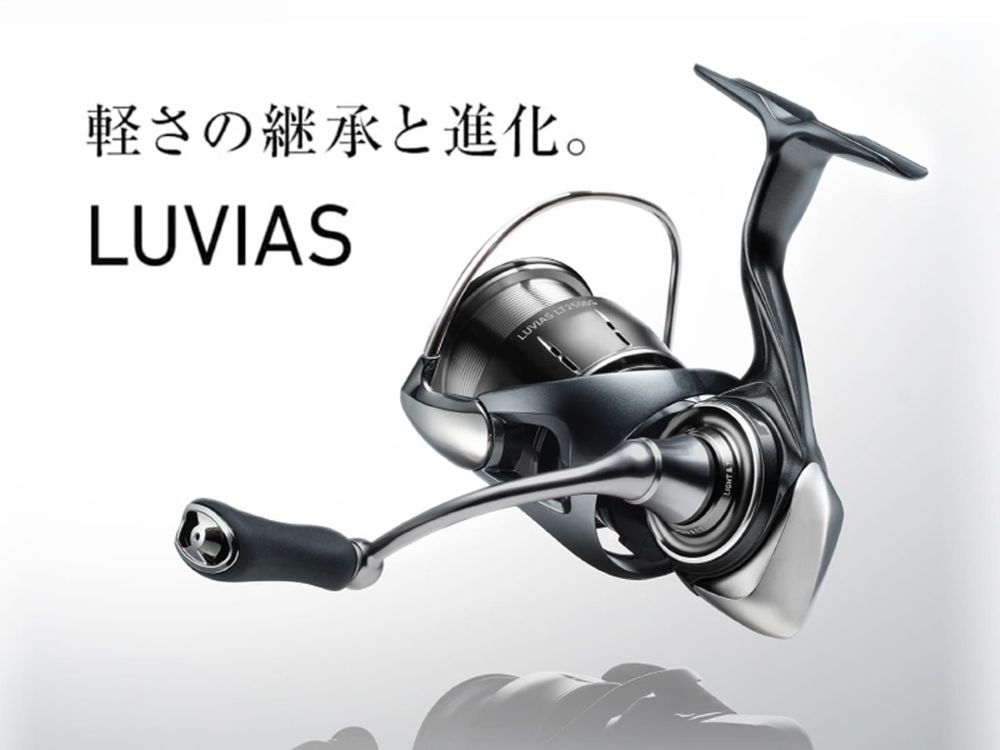
In Your Hand, Astonishing Lightness.
Once you start turning the handle,
it stops exactly where you intend and operates as you wish—so satisfying.
A sense of freedom that seems to draw out your rod’s full potential.
A high-sensitivity world that takes you to the next stage.
Power that won’t lose in a head-on fight with big fish.
Therefore, LUVIAS.
Feature of LUVIAS
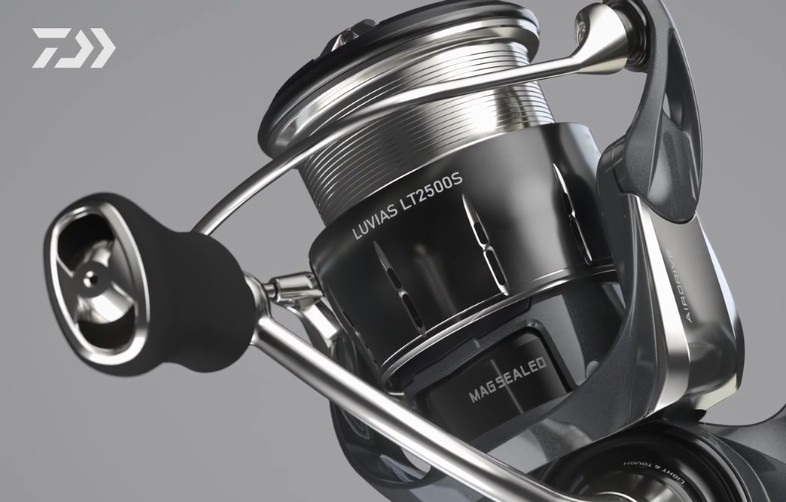

Fusion of AIRDRIVE DESIGN and Monocoque Body
Operability Further Improved.
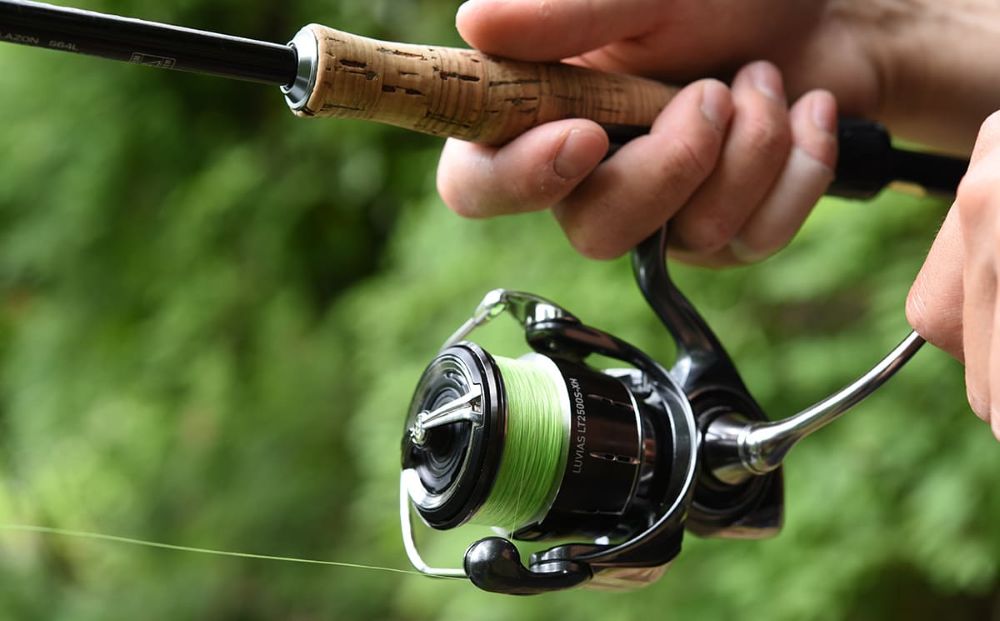
AIRDRIVE DESIGN that improves operability and the tough, powerful Monocoque Body—
technologies that are the new standard for DAIWA spinning—are fused in 24 LUVIAS.
Compare them and you will clearly see the evolved “rotation.”
This produces a higher level of “operability” that allows you to sense lure behavior keenly and control it at will.
LUVIAS packs performance rivaling high-end models.
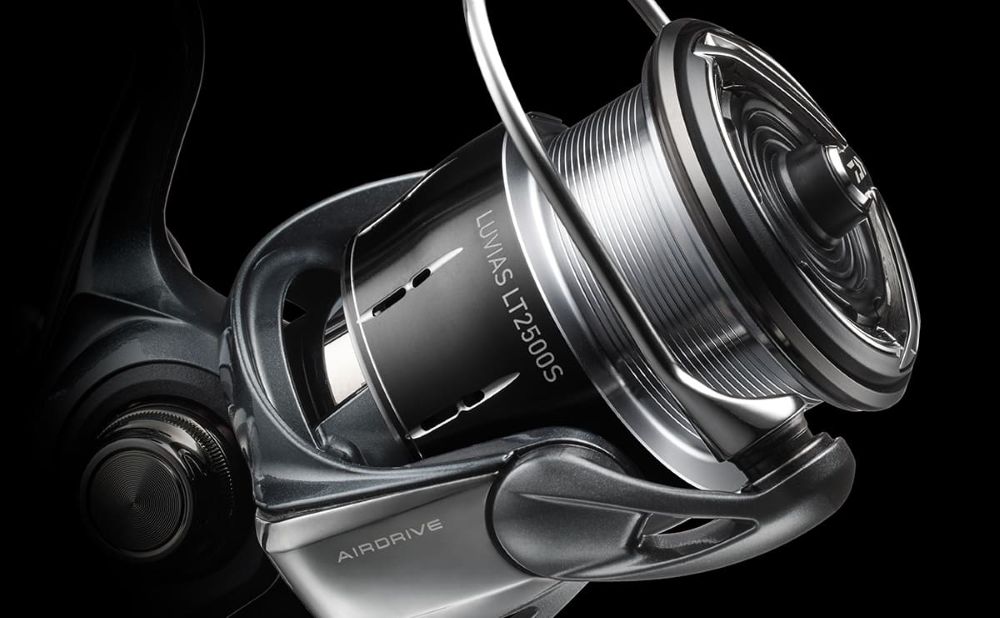
AIRDRIVE ROTOR
Compared to the previous generation, the rotor is lighter while maintaining rigidity.
It brings precise operability that starts with light force and stops at the exact position you intend.

The drag is ATD TYPE-L, pursuing smooth start-up and followability.
On the 5000 size, ATD TOUGH with carbon washers is set for durability.
LIGHT & TOUGH
LUVIAS Is Not Fragile.
The lineup spans from the 2000 class—perfect for area trout and Aji (Horse mackerel) light salt games—to the 5000 class that also handles surf casting and light shore jigging.
While maintaining the LUVIAS pride of being among the lightest in DAIWA, it also has the necessary rigidity and durability demanded by power fishing.
Lightness reduces body burden and fatigue, keeping your concentration longer.
This also enables a world of power fishing that exists precisely because of lightness.
With LUVIAS, that approach is possible.
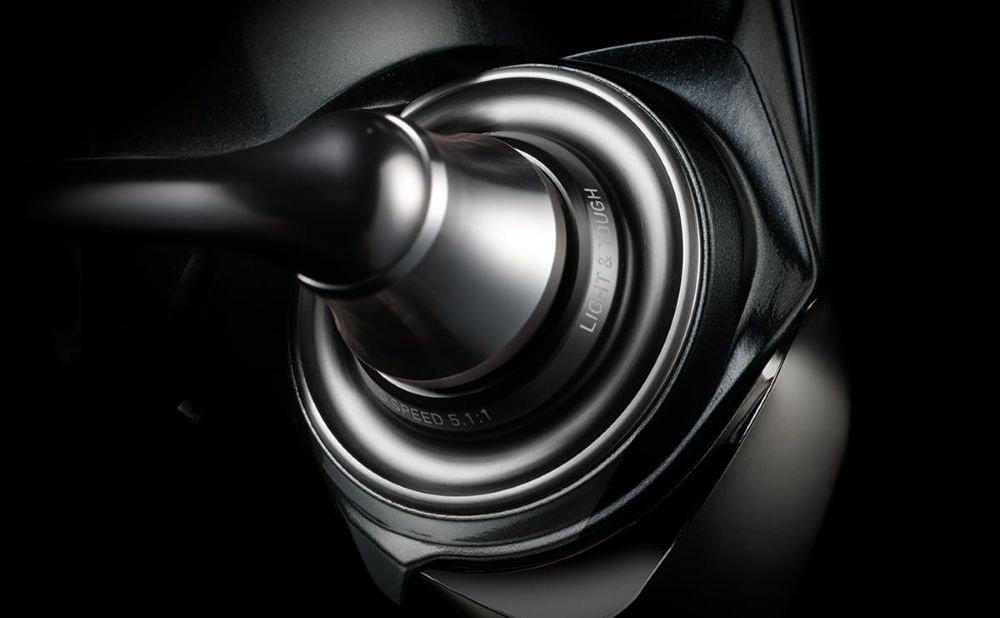
MONOCOQUE BODY -MQ-
DAIWA’s unique technology that combines high levels of rigidity, power, and sealing through a one-piece molded body.
20 YEARS OF HISTORY
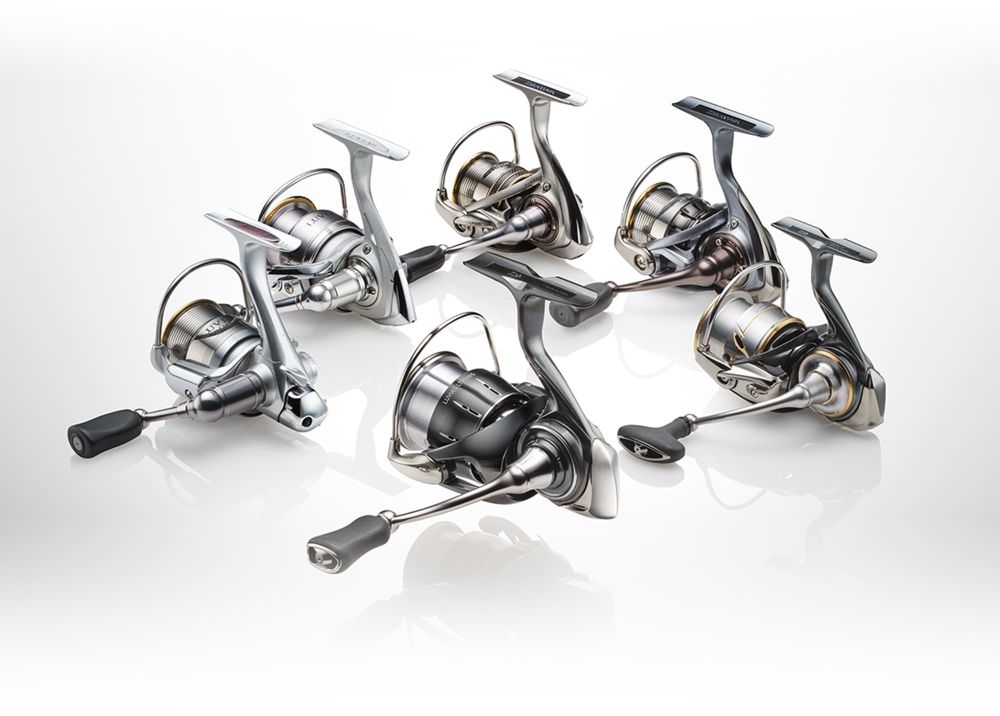
Gunmetallic for the 20th Year
Since its debut in 2004, LUVIAS has been loved by anglers for nearly 20 years.
Many still use decade-old models as active gear.
That history proves the durability of successive LUVIAS, and it is an honor for us that they are cherished for so long.
Where past LUVIAS used a silver base design, the 24 LUVIAS is renewed in gunmetallic × silver.
From here, LUVIAS begins a new history again.
TECHNOLOGY FOCUS

Beyond Lightness.
Achieving Nimble Operability × Major Weight Reduction
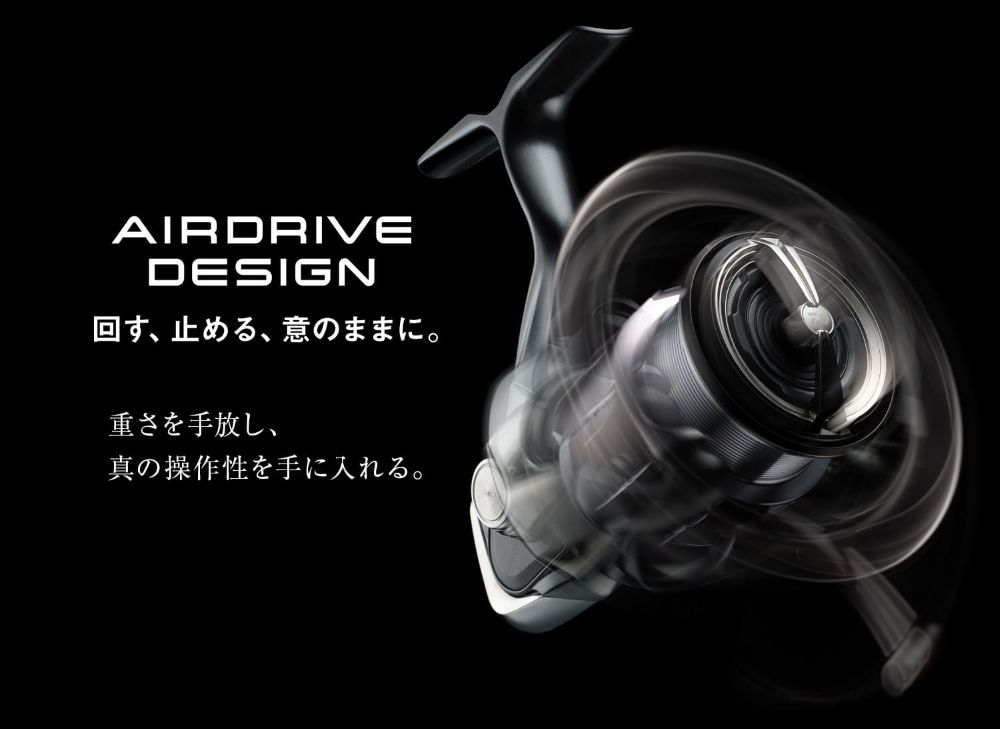
AIRDRIVE DESIGN
Turn, Stop, Exactly as You Intend.
Let go of weight and gain true operability.
The coming future of DAIWA spinning reels: AIRDRIVE DESIGN.
Dramatically lightening the front unit of a spinning reel creates an exceptionally nimble winding feel and high-level operability affecting all fishing actions.
The lightness of rotation brings freedom and possibility.
The new chapter begins with 22 EXIST.
AIRDRIVE DESIGN
Everything Becomes a Symbol of the Future.
AIRDRIVE DESIGN is a next-generation spinning reel design philosophy pursuing lure control exactly as intended by anglers.
It consists of up to four technologies.
The required AIRDRIVE ROTOR produces light start-up and high-response rotation; supporting its performance are the lightweight, trouble-free AIRDRIVE BAIL; the thin-wall AIRDRIVE SPOOL that strips unnecessary material to the limit through precise strength calculations; and the AIRDRIVE SHAFT that supports the main shaft with high-precision collars and separates it from the pinion to enable light winding with extremely little rotational noise even under high load.
Their synergy and improved reel weight balance realize high-level operability.


Improved Weight Balance
By lightening the front unit, front-heaviness when mounted on a rod is reduced.
This further enhances operability during casting and rod action.
AIRDRIVE DESIGN
AIRDRIVE ROTOR

DAIWA has continuously worked to improve rotational response of spinning reel rotors.
From its unique theory, DAIWA derived a new shape that seems cut from a sphere, then thoroughly removed excess material to achieve major weight reduction while maintaining rigidity. This dramatically improves start-up lightness, leading to higher operability and sensitivity.

A design ideal as a rotating body, like being cut from a sphere.
It produces ideal rotational balance.

In strength simulations of the rotor arm, despite being lighter than 18 EXIST, rigidity is equivalent.
As shown, areas with concentrated force are reinforced while unnecessary areas are lightened to distribute load—the AIRDRIVE ROTOR balances lightness and rigidity.
AIRDRIVE DESIGN
AIRDRIVE BAIL

The long-adopted air bail on DAIWA spinning reels used a hollow pipe structure for lightness and rigidity and unique shapes to guide line smoothly to the line roller for trouble-free start-up.
AIRDRIVE BAIL reduces diameter further while keeping required strength to achieve more weight savings. The bail angle is carefully set for smoother transition from bail to line roller.
It supports the performance of AIRDRIVE ROTOR while becoming lighter and more trouble-free.

To better fit modern line selections with less stress, the bail tilt angle is meticulously set.
As the line angle becomes more obtuse toward the line slider, it is more easily guided to the line roller.

The bail structure around the line roller was redesigned and diameter changed from φ3 to φ2.4 versus 18 EXIST.
This achieves about 33% weight reduction (2500 size).
Strength remains sufficient for actual fishing.


AIRDRIVE BAIL also offers a wire type that adopts a solid structure rather than insisting on hollow pipes, maintaining sufficient strength for actual use while pushing lightness. Compared to conventional wire bails, line troubles are greatly improved.

On the wire type, the bail tilt angle is changed and the arm lever and line slider shapes are revised, plus a “Tangle-Prevention Roof” is installed above the line roller. These measures almost completely shut out line wrapping.
AIRDRIVE DESIGN
AIRDRIVE SPOOL

Under precise strength calculations, unnecessary material is thoroughly shaved off for a thin-wall design.
Not only the line-winding area and skirt, but internal cutouts are uncompromisingly lightened.
A lighter spool improves start-up and operability during casting.
A newly developed low-resistance drag click mechanism enhances response during drag operation.

While thinning the spool, hole machining is not used—composed only of smooth silver surfaces to embody elegance.
The skirt draws a smooth curve, tapering toward the bottom.


The drag click mechanism becomes a separate new-structure part.
It produces a pleasant click while reducing operating resistance so the drag works more smoothly without stack.
AIRDRIVE DESIGN
AIRDRIVE SHAFT

DAIWA’s Linear Shaft makes friction zero by setting the main shaft non-contact with the pinion gear.
AIRDRIVE SHAFT further supports both ends of the pinion with ball bearings to maximize conversion of handle input power into rotor rotation.
Supporting the main shaft with high-precision collars thoroughly reduces rotational noise.
Non-Linear/AIRDRIVE Shaft Models

In models without Linear/AIRDRIVE Shaft, the main shaft is directly supported by the pinion inner diameter, causing frictional power loss when reeling under high load.
* Images are for illustration.
AIRDRIVE Shaft-Equipped Models

In AIRDRIVE Shaft models, the main shaft is supported by collars (1, 2 above) and kept non-contact with the pinion to make friction zero.
While this structure itself is like the Linear Shaft, AIRDRIVE refines collar precision even more.
This yields smooth, silent rotation performance.
Supporting both pinion ends with ball bearings (3, 4 above) realizes powerful winding performance.
* Images are for illustration.

Do you think a reel that “spins on and on” is a good reel?
It keeps spinning because the rotor is heavy. That reel may actually disadvantage your fishing greatly.
The rotor should be light.
For years, DAIWA has adhered to the belief that “the rotor of a small spinning reel should be light.”
Of course, we cannot sacrifice strength for lightness.
Balancing both, we aim for the ideal rotor.
Its culmination is
the AIRDRIVE ROTOR.
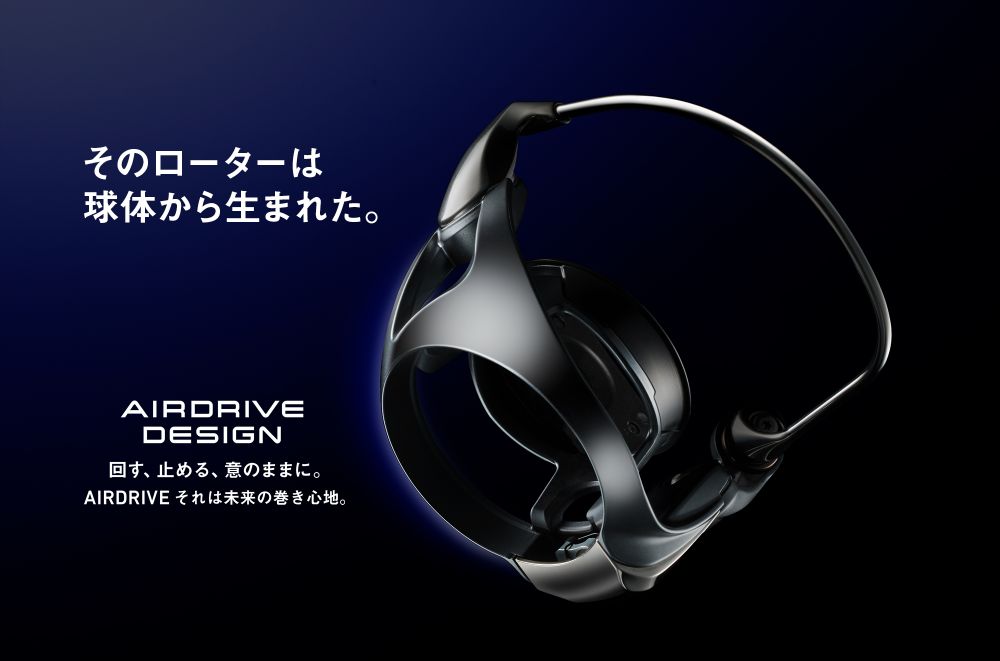
Chapter 1
How does rotor weight affect spinning reel performance?
The rotor’s role is to “wind line onto the spool.”
On bait reels, turning the handle rotates the spool itself to take up line.
On spinning reels, the spool does not rotate; the rotor rotates to wrap line onto the spool.
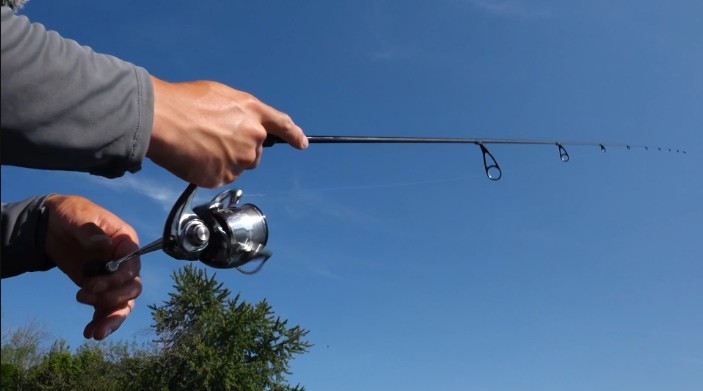
This rotor must maintain balance as a rotating part and also have sufficient strength.
If the rotor flexes or warps, it cannot wrap line evenly onto the spool.
It also needs to withstand strong fish pulls.
However, prioritizing strength at the expense of lightness is not acceptable.
The rotor is a very large part in a spinning reel, and the heavier it is, the more disadvantageous it becomes for anglers.
Why is that?
Rotation produces inertia.
Rotational inertia increases the heavier the rotating object and the farther its mass is from the axis.
When inertia is large, more force is needed to start rotation, and once rotating, it tends to keep rotating longer.
In formula, it looks like this:
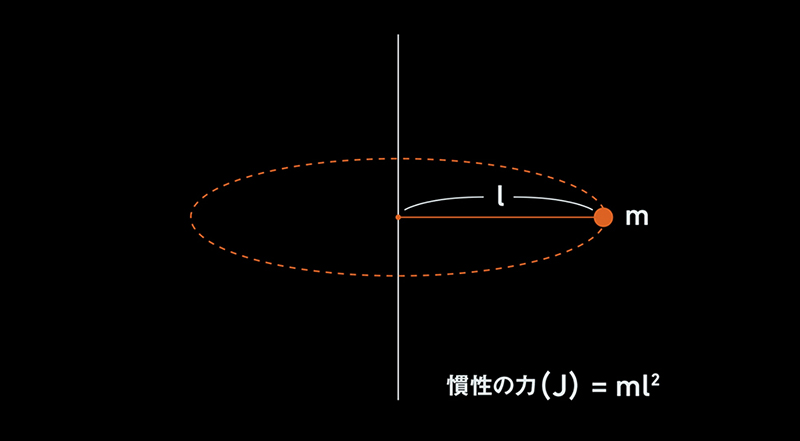
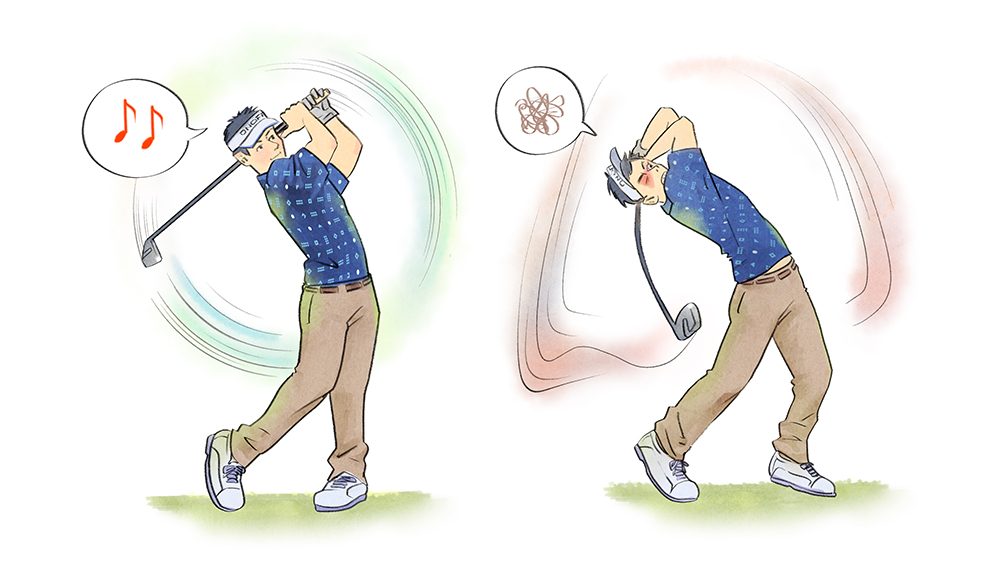
* Imagine swinging a golf club with a heavy head on a long shaft versus a light head on a short shaft.
Turn the handle vigorously.
Even if you release your hand, it keeps turning—this is inertia.
The handle keeps rotating for a while after your hand leaves the knob.
That is inertia created by a heavy rotor.
The heavier the rotor, the greater the inertia.
Reel A has a rotor about 15 g heavier than Reel B.
Turn both handles with the same force at the same time and see which keeps rotating longer.
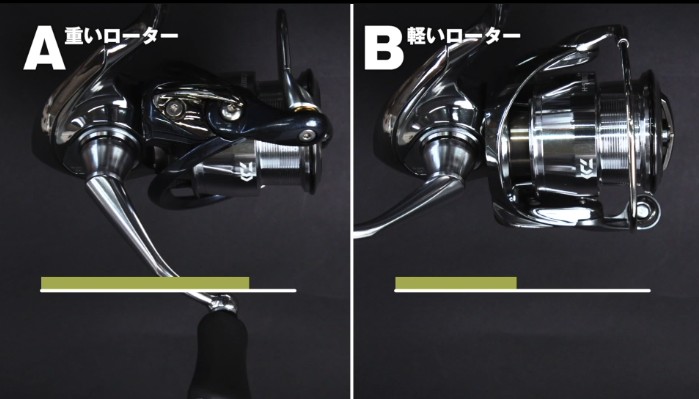
Reel A keeps rotating longer.
Thus, the heavier the rotor, the longer the handle spins.
But a handle that keeps spinning is due to rotor inertia—
not necessarily a better reel.
A heavier rotor also makes start-up heavier.
Compare the force needed to start the handle between Reel A and Reel B.
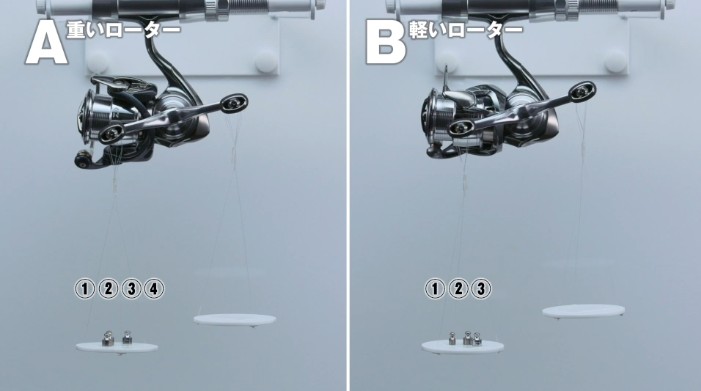
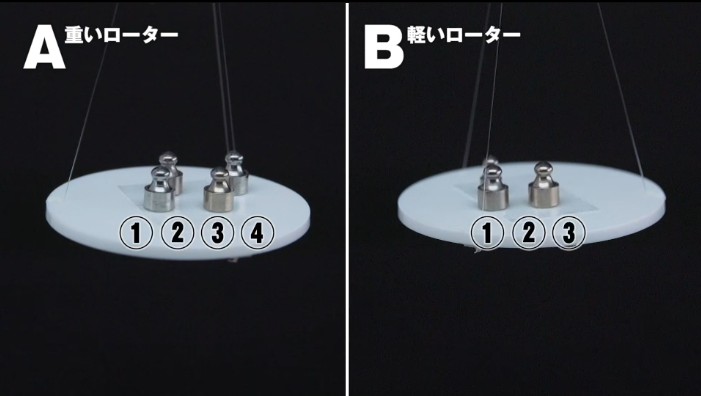
The heavier-rotor Reel A needs more force to start.
So what problems does large inertia cause in actual fishing?
Chapter 2
What benefits does a light rotor bring to anglers?
Large inertia from a heavy rotor negatively affects handle operability and winding sensitivity.
A heavy rotor degrades operability.
With larger inertia, more force is needed both to start and to stop the handle.
This causes delays in timing when starting and stopping.
(1) Lure start-up is delayed.
When start timing is late, in a river for example, the lure may be swept by current during that brief lag, and you cannot target the exact spot or course you intend.
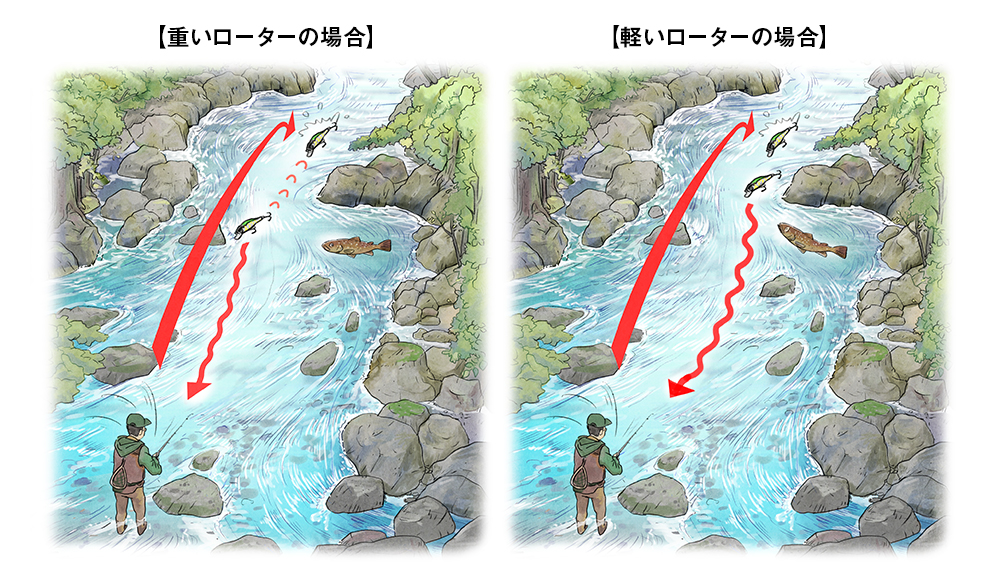
(2) You cannot impart the exact action you want.
Delays at start and stop make it difficult to produce agile retrieve actions.
It is also harder to insert pinpoint pauses when you sense a change.
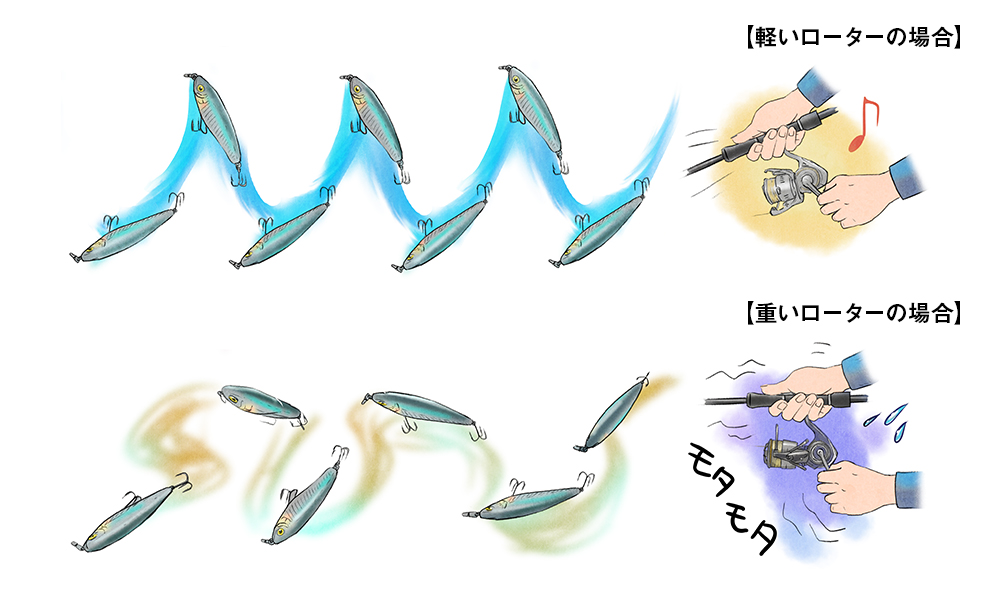
A heavy rotor also degrades winding sensitivity.
Because a heavy rotor tends to keep rotating, it blunts sensitivity.
You think you are turning only with your own power, but rotor inertia adds another force. Even on a bite, the line may be taken up automatically, making it harder to feel as sensitivity at hand.
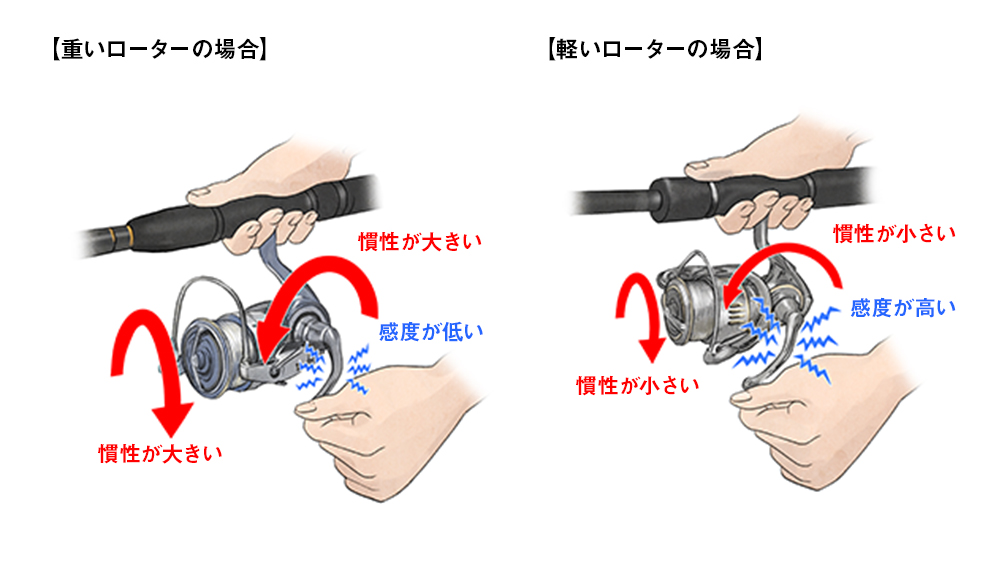
(1) It becomes harder to read what is happening underwater.
You judge current strength by changes in winding resistance, but inertia from a heavy rotor obscures that feel.
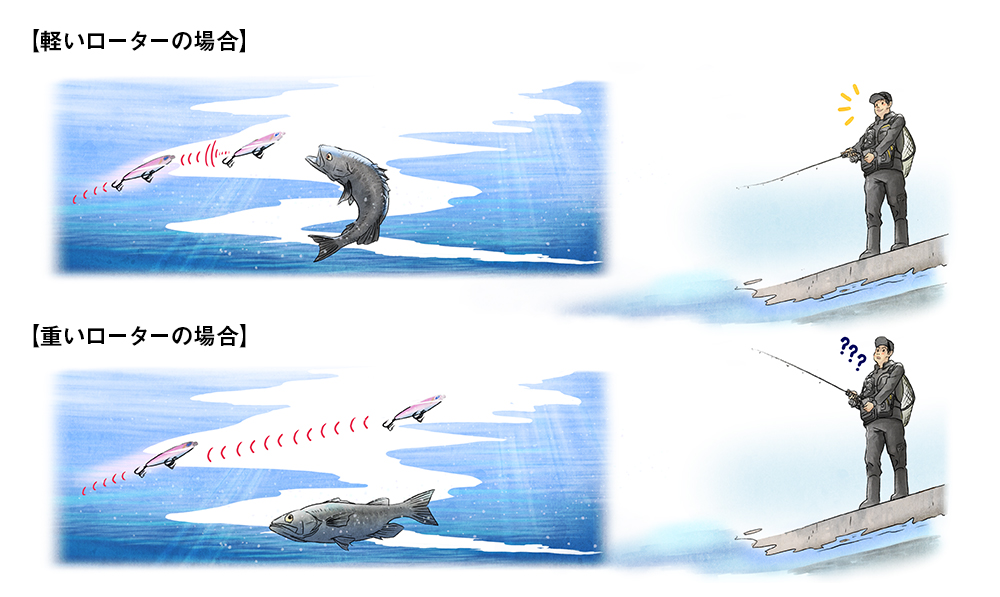
(2) It becomes harder to feel bites.
Bites are sensed as changes in resistance at hand during retrieve.
With a heavy rotor, even if there is a bite, inertia continues to wind, making bites harder to perceive.
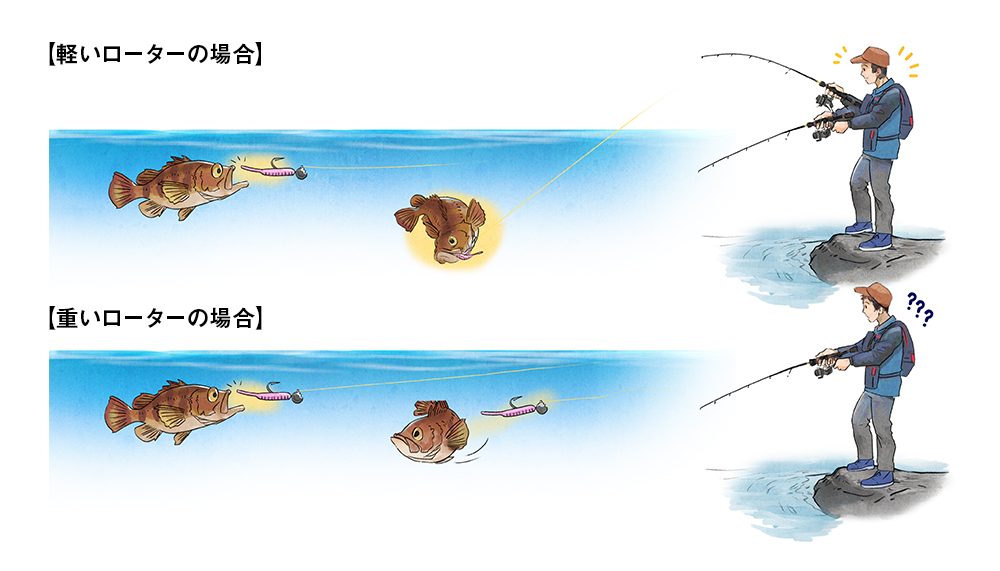
Thus, a heavy rotor brings major disadvantages to anglers on small spinning reels.
On large spinning reels, rotor inertia can sometimes aid easy winding and reduce fatigue during retrieve.
However, for small spinning reels requiring delicate operability and high sensitivity, the disadvantages of rotor weight are issues that must be solved.
Therefore, DAIWA has long sought a light, strong, low-inertia rotor for small spinning reels.
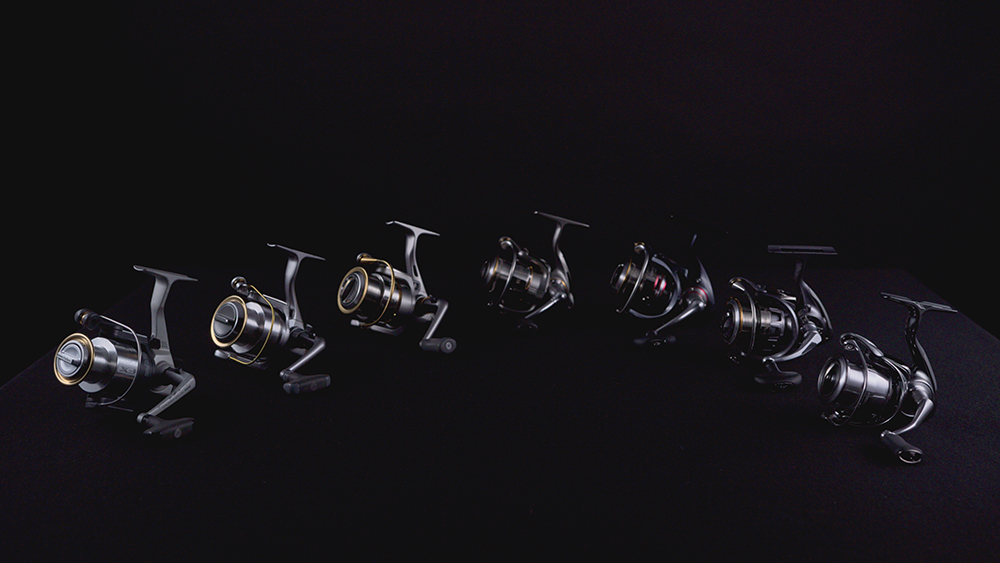
Chapter 3
As a rotating body, the most rational shape is the AIRDRIVE ROTOR.
We arrived at the spherical AIRDRIVE ROTOR as the most rational shape for a rotating body.
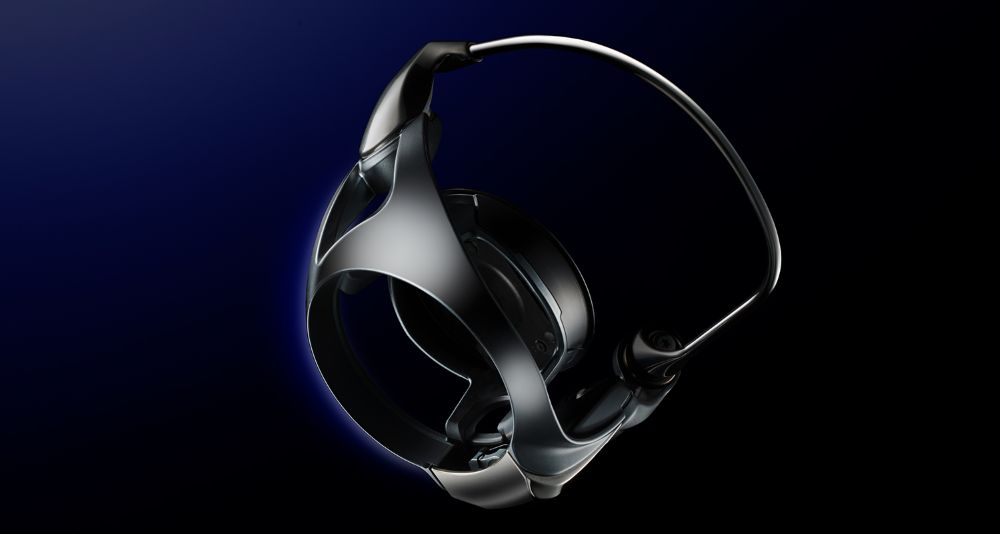
Why is a spherical AIRDRIVE ROTOR rational?
Reason (1) A sphere is ideal as a rotating body.
A sphere is symmetrical around the axis (center line) and maintains perfect balance—ideal as a rotating body.
Reason (2) A sphere is strong.
Moreover, a sphere is considered the strongest shape against external forces on Earth.
Force applied at one point is dispersed around—this is why domed buildings are strong.
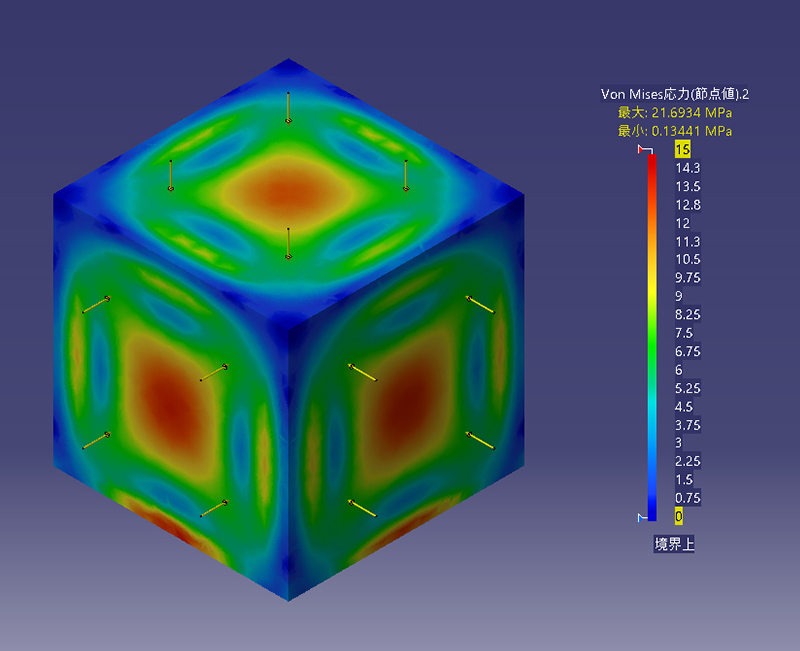
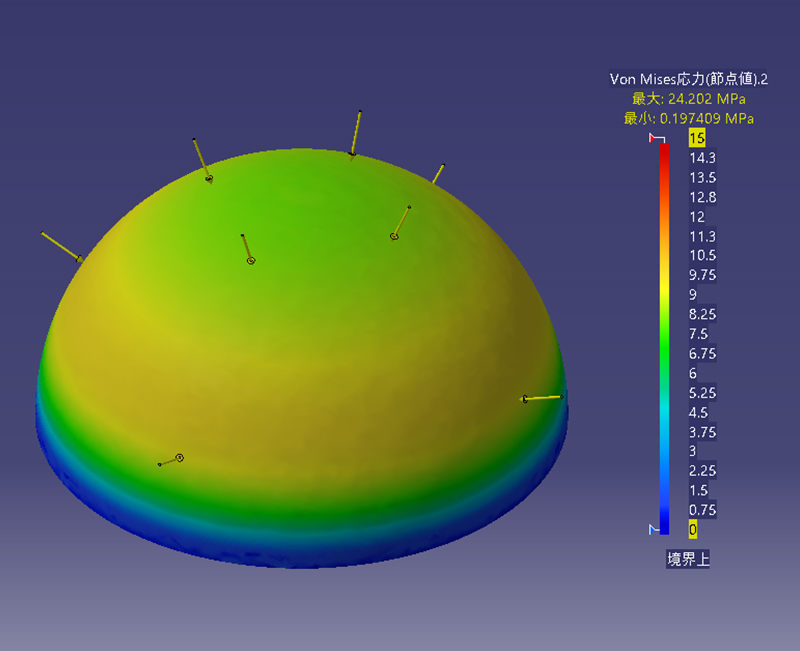
As a sphere, the AIRDRIVE ROTOR disperses applied force widely to realize higher strength than before.
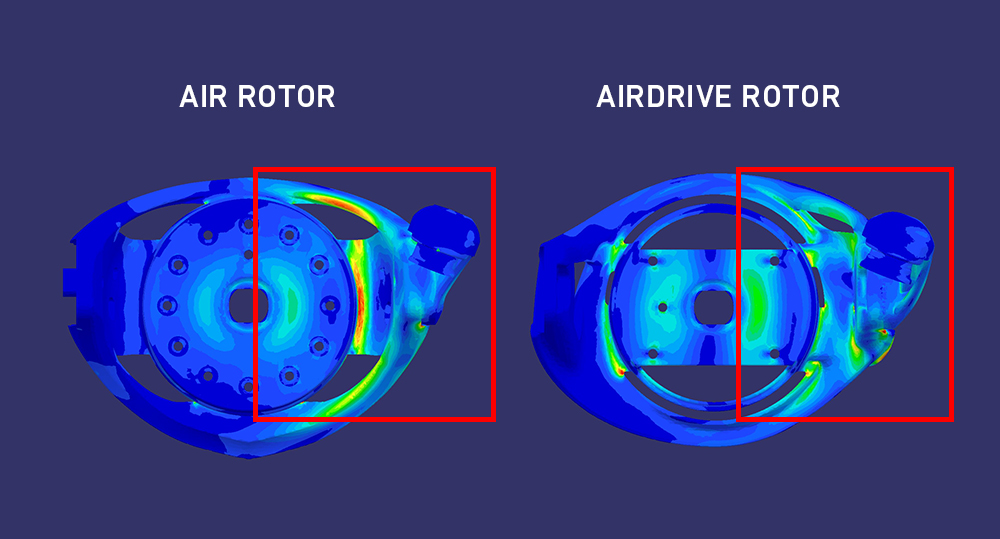
Reason (3) Because it is strong, it can be made lighter.
A rotor needs a certain strength.
Once sufficient for the intended fishing style, more is not required.
Achieving greater strength allows the AIRDRIVE ROTOR to convert surplus strength into lightness while maintaining necessary strength.
As a result, it realizes about 16% weight reduction over previous rotors (*1).
[Rotor Unit Weight Comparison]

*1 Reduction varies by size.
Reason (4) A sphere enables lower inertia.
A spherical target results in a more compact shape, further reducing inertia, coupled with lightness.
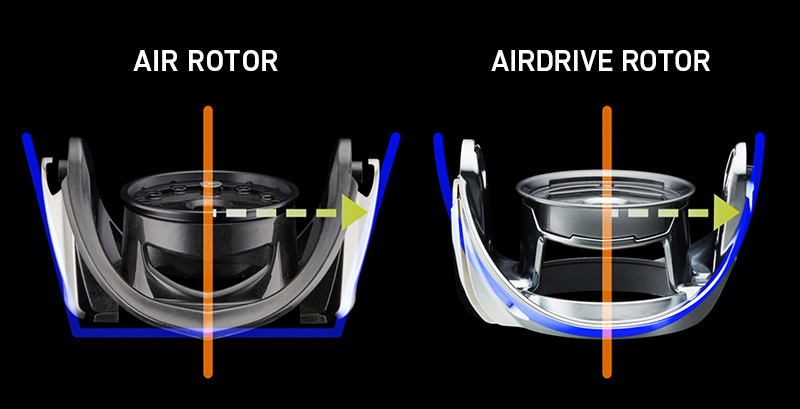
Compared with square rotors, the AIRDRIVE ROTOR achieves about 16% lower inertia (*2).
[Rotor Unit Inertia Comparison]

*2 Inertia values vary by size, maximized at 2500 size.
Thus, the AIRDRIVE ROTOR enables the extreme low inertia required for small spinning reels with the most rational spherical shape.
Achieving a spherical rotor required a reversed approach—designing from the outside.
Conventional rotors were designed from the inside, then strength and balance were addressed outside, causing parts designed later to protrude squarely on the exterior.
By contrast, the AIRDRIVE ROTOR starts design from the outer sphere, then hollows the inside while managing strength and balance—this reversed idea enables an ideal spherical balance.
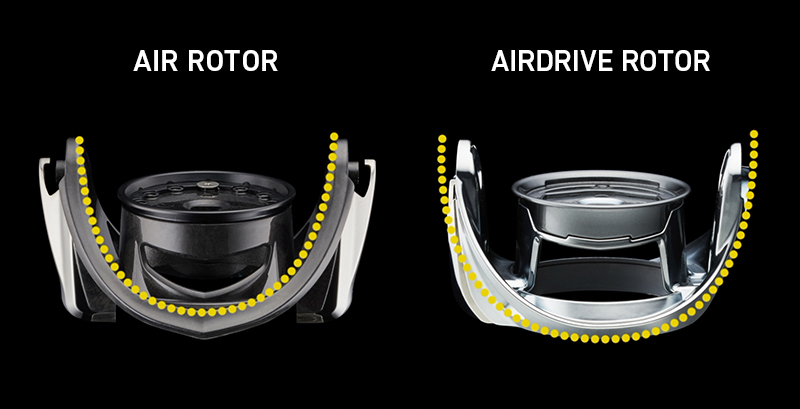
The rational sphere of the AIRDRIVE ROTOR realizes unprecedented low inertia.
A sphere offers better operability.
A sphere offers higher sensitivity.
With its rational spherical shape, AIRDRIVE ROTOR achieves high lure operability—you can start smoothly and stop precisely—and high sensitivity that lets you feel small bites and subtle current changes.
A sphere has created a spinning reel that catches more fish.

Reliable Toughness, ZAION Material.
Metal-Class Strength × Lighter Than Metal
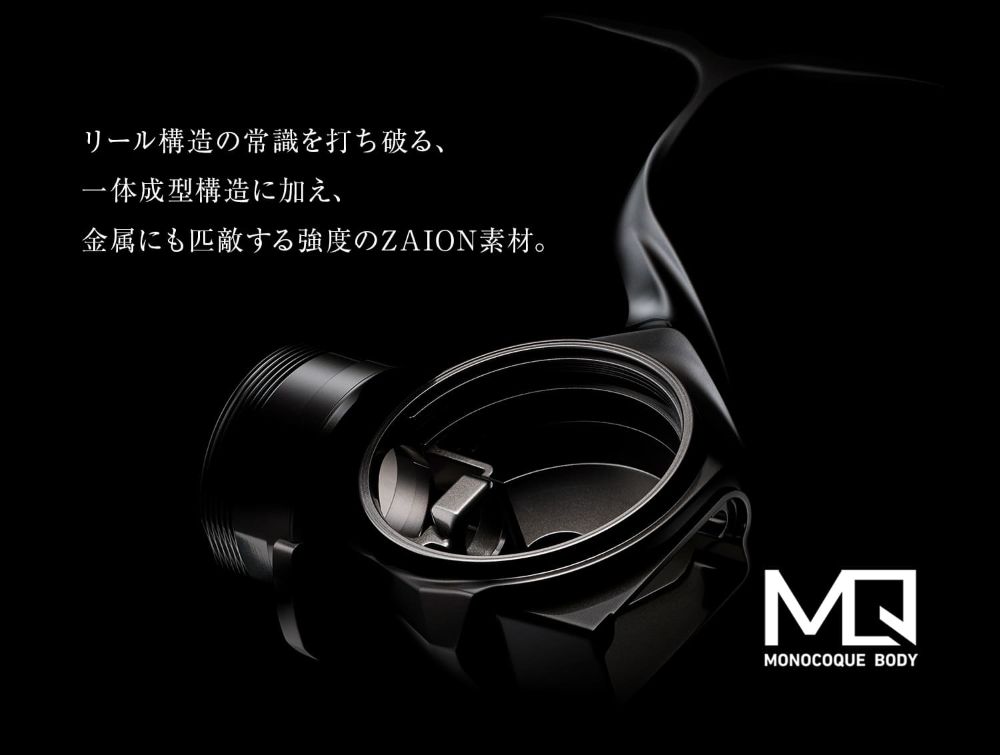
In addition to a one-piece structure that breaks reel-construction conventions, ZAION material offers strength comparable to metal.
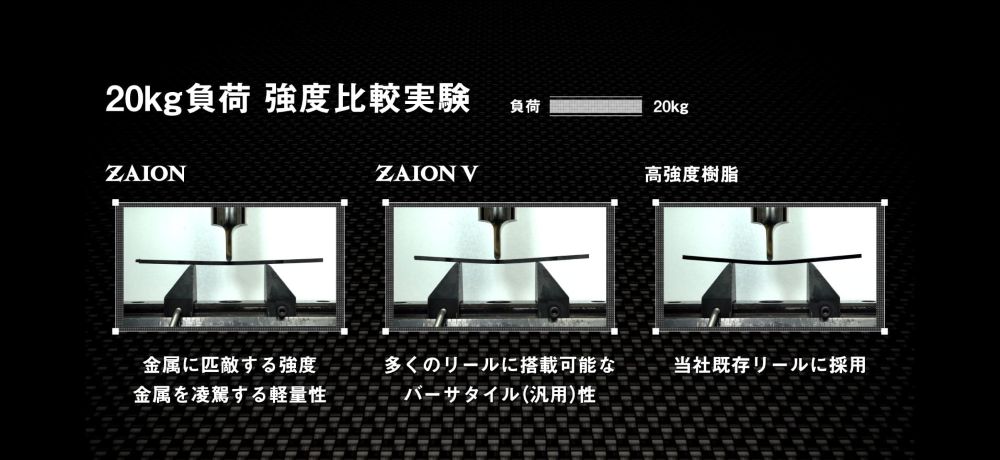

A One-Piece Structure That Breaks the Common Sense of Reel Construction
Monocoque Body means MONO (one) - COQUE (shell).
The completely asymmetrical new shape symbolizing the toughness of a single shell heralds a new era, breaking the common sense of reel design.

A New Structure Embedding the Gear Directly into the Body
Conventional spinning reels usually support the drive gear between a body and body cover fixed by several screws.
Seeking higher precision and rigidity, the body cover was eliminated and a high-precision plate is screwed directly into the body—this is the Monocoque Body.
Maximizing Gear Space
The new structure raises gear support precision and improves rigidity and sealing.
It also frees space previously used by screws, enabling the drive gear to be enlarged to the limit.
Larger Gear Diameter = More Power

Monocoque Body
STORY #01

What makes a spinning reel strong?
“A tough gear, right?”
“A solid body material.”
Exactly.
But, to speak frankly, these are evolutionary refinements—replacing parts with newer materials and tech on old blueprints.
We are proud of this refinement.
Yet DAIWA spinning reels step onto a path of evolution.
With the Monocoque Body.
The Monocoque Body is a new body structure that will become the axis of future DAIWA spinning reels.
Where conventional spinning reel bodies consist of two parts, the Monocoque Body is a single piece.
Two-part structures can flex under load at an invisible level, adversely affecting gear meshing.
No matter how tough the gear, its full potential may not be realized.
A one-piece Monocoque Body flexes less.
Protected by a solid body, the gear continues to run smoothly inside.
It is the fusion of the history of refinement with true evolution—the Monocoque Body.

[Exploded View of Monocoque Body (19 CERTATE)]
The internal structure is simple, housing only what is necessary with no waste. This also makes the design compact and refined.
Monocoque meets lightness, toughness, and styling.

Stores a large-diameter gear nearly at body limits.
The drive gear is among the largest in class.
It is housed with clearance so tight it nearly touches the body.
This is possible thanks to the high-precision, high-rigidity Monocoque Body.
Monocoque Body
STORY #02

When discussing reel toughness, gears come first.
They are the heart that produces power.
Of course they must be tough.
But if the body supporting them flexes under heavy load, gears will rattle inside, mis-mesh, and lose power transmission.
Mismatched gears can also damage each other.
Thus, even with tough gears, a weak foundation nullifies the benefit.
Conventional bodies are built from two parts.
A Monocoque Body is single-piece. Intuitively, the difference in strength and resistance to flex is significant.
Gears mesh solidly without play and fully exert their power.
And inside the Monocoque Body are DAIWA’s proud TOUGH DIGIGEARs—of huge size.
In conventional structures, screw holes to join the two halves consume internal space, limiting gear size.
A one-piece Monocoque Body needs no such holes, providing more internal space to house larger gears in the same body size.
Experience the limit-breaking power created by a rigid body and giant drive gear.

Drive Gear
The drive gear used in 18 EXIST and 19 CERTATE is DAIWA’s TOUGH DIGIGEAR—cold-forged aluminum with ultra-precise machine cutting to achieve ideal tooth faces.

Efficiency Graph and Measurement Method
Reels lose some power from handle input through many parts.
Winding efficiency shows how efficiently power is transmitted without loss.
19 CERTATE achieves about 15% higher efficiency than 16 CERTATE.

Monocoque Body
The Monocoque Body is covered by an engine plate that itself acts as a giant screw, making it resistant to shifting and flex under heavy load.
Without needing screw holes, it frees internal space to house a larger, more powerful drive gear.
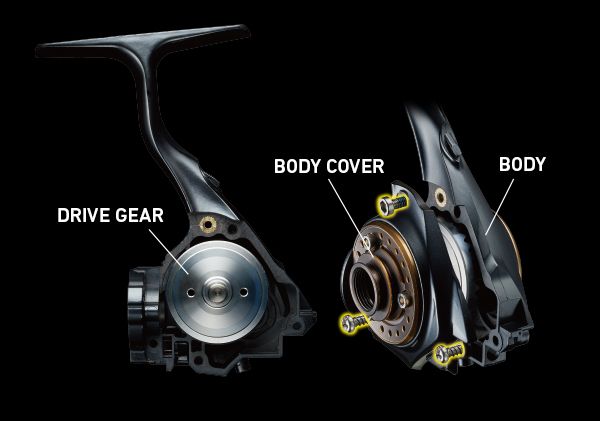
Conventional Structure
A body cover is fixed to the body with 3-4 screws.
When flexing forces act on the body, these thin screws become stress centers, making body/cover misalignment more likely under high load.
Screw holes also narrow internal space, inevitably reducing drive gear size.
Monocoque Body
STORY #03

Water entering the reel body—especially seawater with salt—is a formidable enemy.
Seawater causes salt lock, seizure, and rust, drastically shortening reel life. How to prevent this?
We want you to use your beloved reel as long as possible with initial performance intact.
Hence, MAGSEALED. Using magnetic fluid oil on rotational axes creates a system that powerfully repels invading water—literally oil versus water.
MAGSEALED greatly reduces salt damage.
But water is truly troublesome.
Even with high-precision body/cover mating, perfect sealing is difficult. Under heavy load, flex can create micron-level gaps.
That’s enough for water to enter.
What if the body itself flexes less?
A one-piece Monocoque Body.
Because it is one piece, ingress routes are fewer.
Its high rigidity resists flex, making gaps less likely.
Thus, the Monocoque Body inherently offers much higher waterproofing than conventional structures.
One request:
Rinse with room-temperature fresh water after use.
It’s the key to long life.

Comparison with Conventional Structure
Conventional structures fix body and cover with 3-4 screws.
While sealing is strong around screws, other areas are less certain, no matter how precise the mating surfaces.
To ensure waterproofing, packing must be added, complicating structure and reducing internal space—forcing smaller gears or larger bodies.
A Monocoque Body needs only a packing around the circular engine plate—simple, highly precise, and space-efficient—thus enabling high waterproof performance.

MAGSEALED
MAGSEALED is DAIWA’s original waterproof mechanism.
Magnetic fluid oil (mag oil) is placed at key waterproof points such as the pinion, line roller, and drive-gear-end bearings to shut out water ingress.

Monocoque Body
STORY #04

Monocoque Body brings both “lightness” and “strength.”
For example, compared with non-Monocoque predecessors, weight is reduced by over 30 g, and a strength index—winding efficiency—increases by about 15% on 18 EXIST and 19 CERTATE.
If you choose the same class reel with Monocoque Body, first you will feel the benefits of “lightness.”
- Faster swing for longer casts
- Freer handling allows more technical casts from various angles and improved handling during lure action and fights
- Improved sensitivity
- Reduced fatigue and longer-lasting concentration
“Strength” brings:
- Power when fighting fish
- Longer-lasting initial performance
The Monocoque Body has deeper potential.
For instance, lightness.
If strength is up, for some targets a one-size smaller reel may suffice strength-wise.
Depending on line capacity, comfortable handle length, and tackle balance, if strength requirements are met, a smaller size is an option—dramatically reducing weight.
Conversely, if you are satisfied with weight, using a larger size could yield even more power.
Thus, choose by “strength” to gain lightness, or by “weight” to gain strength.
For example:
The 19 CERTATE LT5000D-XH landed multiple 10 kg-class amberjack during durability tests with drag fully locked, and passed post-checks without issues—yet it weighs just 295 g.
Where shore casting, light offshore casting, and light jigging once needed 400–500 g SW reels, now a sub-300 g reel handles them with ease.
A sub-300 g reel used to be 3000-class; thus it can serve stress-free for seabass and also cover more powerful fishing.
Depending on angler skill and tackle balance, Monocoque can drastically change standard setups in some genres.
If Strength Is the Same, Go Lighter. If Weight Is the Same, Go Stronger.

Go Stronger at the Same Weight
Comparing old and new EXIST weights, the old 2508PE and the new LT3000-XH both weigh 195 g.
A larger body housing a bigger drive gear is as powerful—at the same weight.
A 2500 size covers ports and in-river seabass and Eging (Squid Jig Fishing); a 3000 size also tackles open-ocean surf.
It retains versatility while keeping the same weight.

Go Lighter at the Same Strength
Focus on the 5000 class.
For yellowtail, small amberjack, mid-size amberjack, Spanish mackerel, dorado, etc., where SW models were heavy and general-purpose large sizes lacked power, the large Monocoque CERTATE fills the gap.
Depending on tackle settings, enjoy a lighter big game.
| 24 LUVIAS Custom Parts – Spare Spools, Drag Washers, Reel Stands & More!


![Photo1: [DAIWA] 24 LUVIAS (LT, SF, ST LT, ST SF) [LUVIAS] Series Specification List (1)](https://www.hedgehog-studio.co.jp/phone/data/hedgehog-studio/_/70726f647563742f32303235313031305f3339623934362e6a706700363030000074006669745f686569676874.jpg)